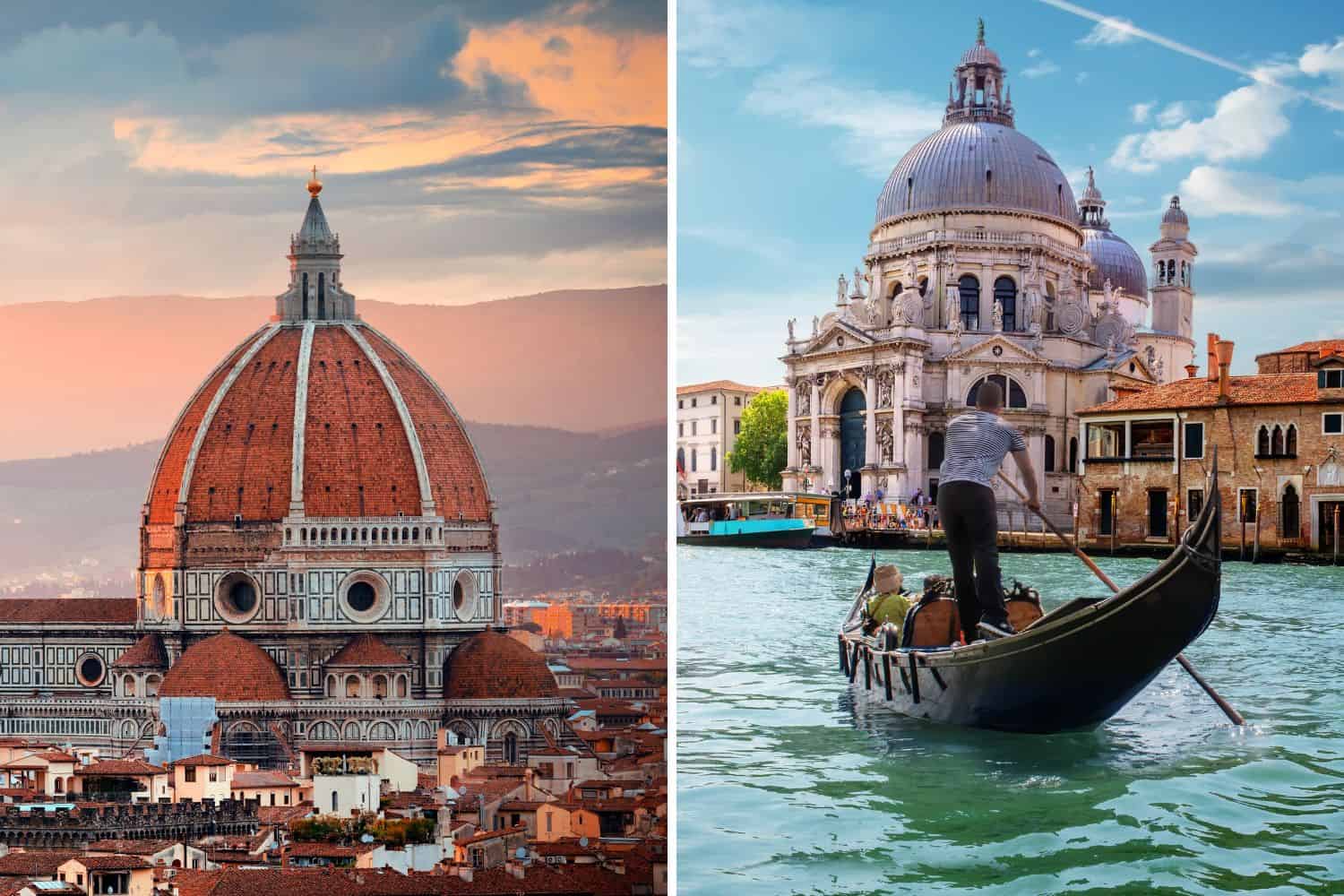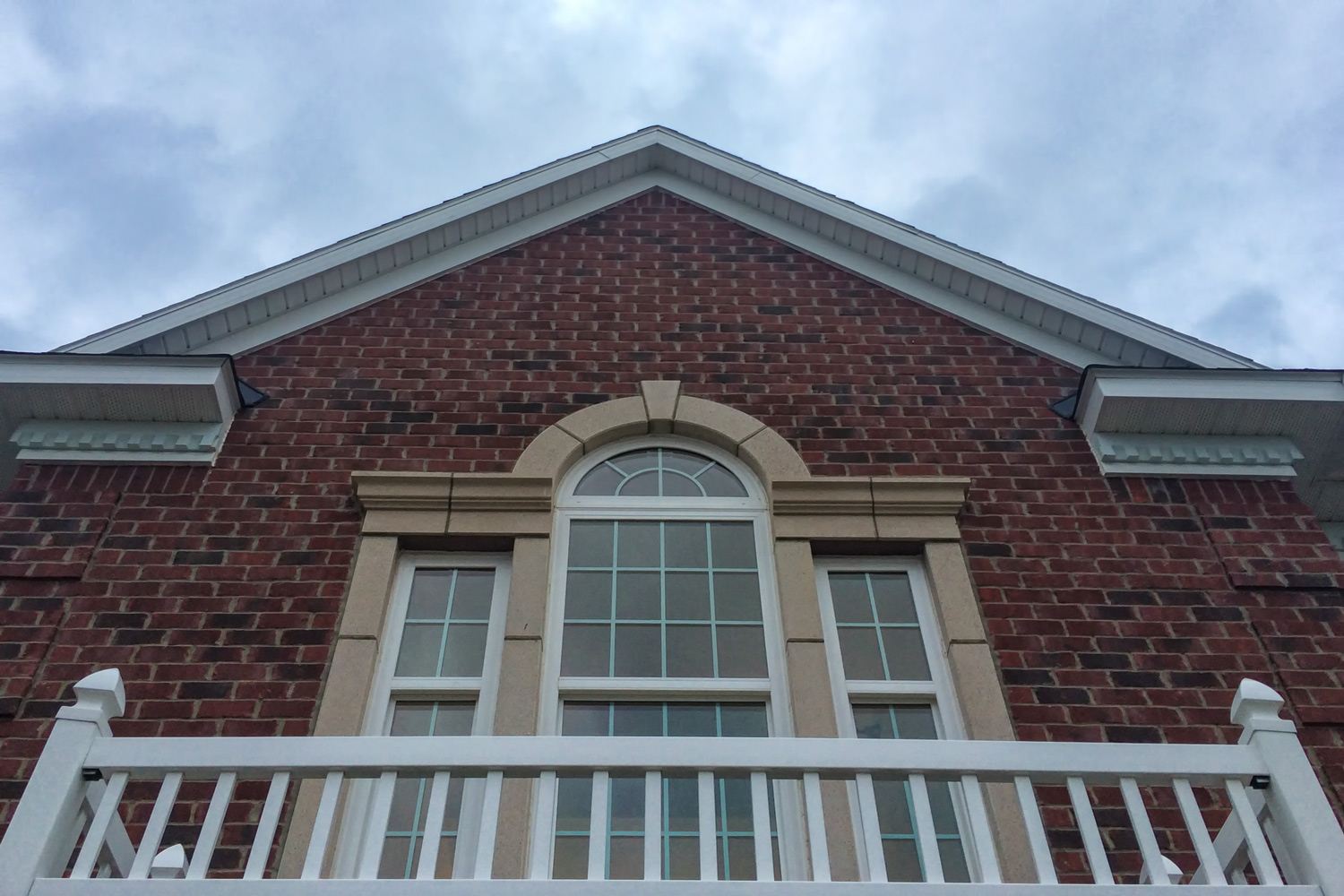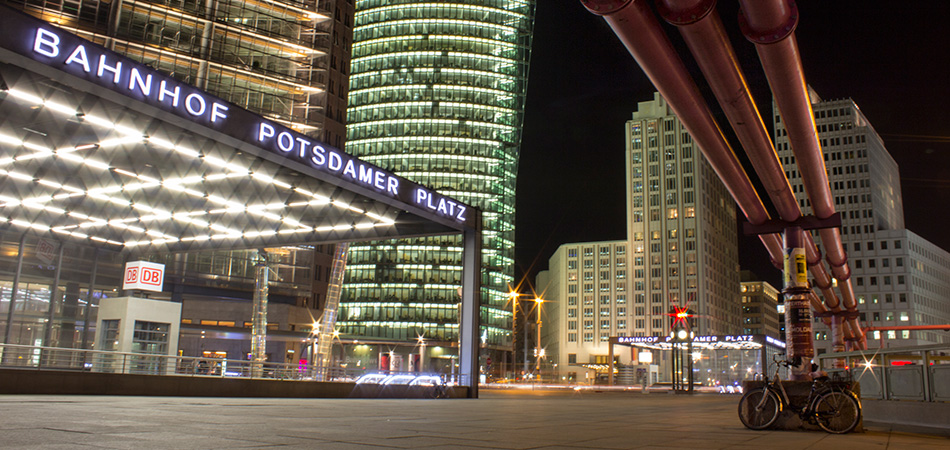Florence or Venice? Which Spot in Italy to Travel To
Words by Dalene Heck / Photography by Pete & Dalene Heck
A common question we often get asked about our travels in Italy is, “Which should I visit, Florence or Venice?”
Our answer is usually, “Why not BOTH?”!
They are equally incredible Italian cities and are genuinely unique; honestly, they aren’t even fair to compare. But if you’re on a limited travel schedule, we will try to make your decision a bit easier by offering our thoughts below.
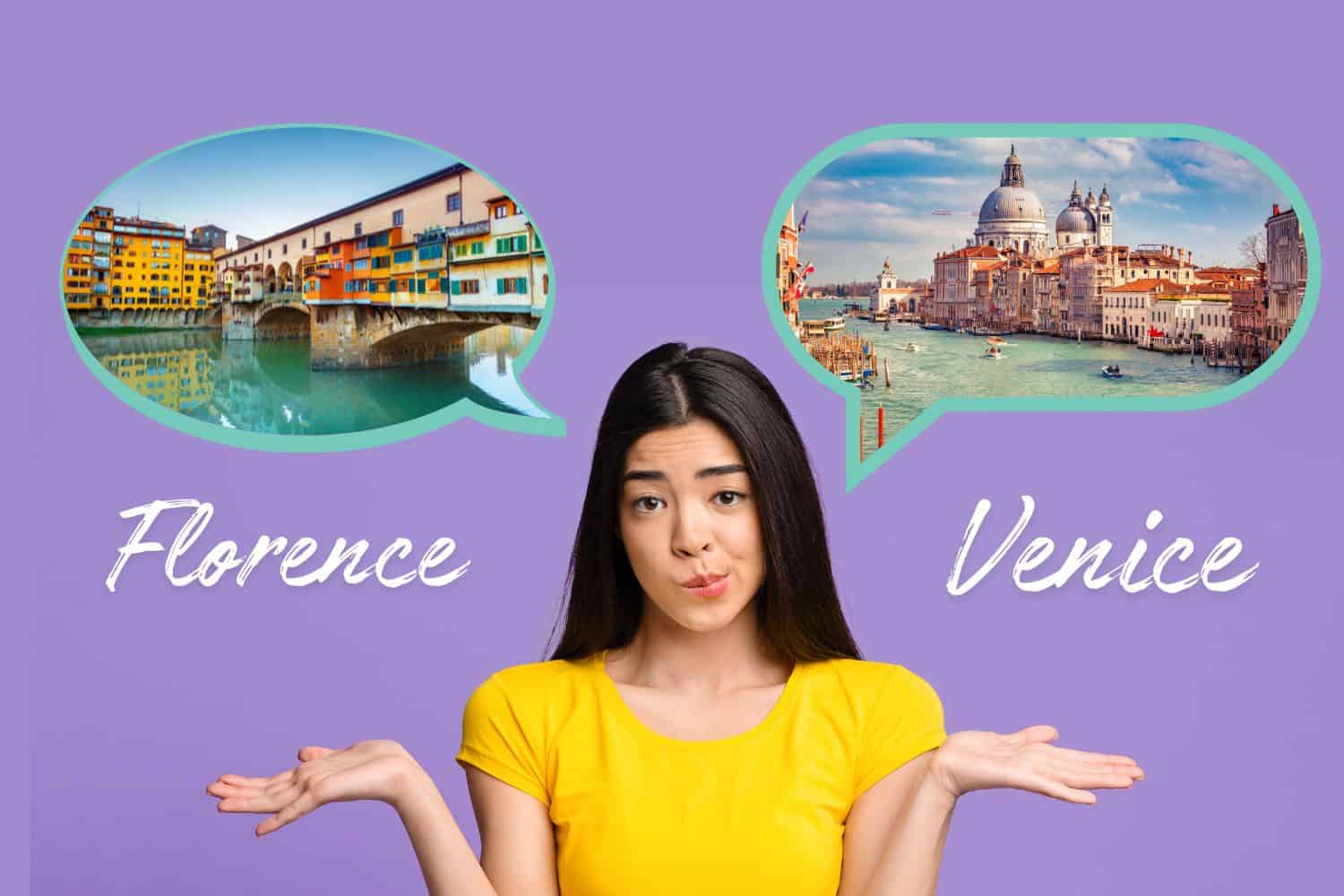
Choosing between Florence and Venice is like picking between two flavours of gelato—both are delicious, but each offers a unique experience.
If you’re a romantic at heart, Venice’s winding canals and gondola rides can whisk you away to a dreamy, floating world. Picture yourself gliding under the Rialto Bridge, serenaded by a gondolier, as you soak in the city’s ethereal charm.
On the other hand, Florence is a feast for the senses with its Renaissance art galleries, Tuscan landscapes, cultural attractions, and rich history. Wander across the Ponte Vecchio, indulge in a scoop of gelato as you admire the Duomo, or lose yourself in the masterpieces of the Uffizi Gallery. Florence is perfect for those who crave history, art, and a warm Tuscan sun.
Both have excellent food and are easily accessible from Rome by train (yay)! But both also have scores of tourists to contend with (ugh). It’s important to weigh the good with the bad when making your decision. We break it down below.
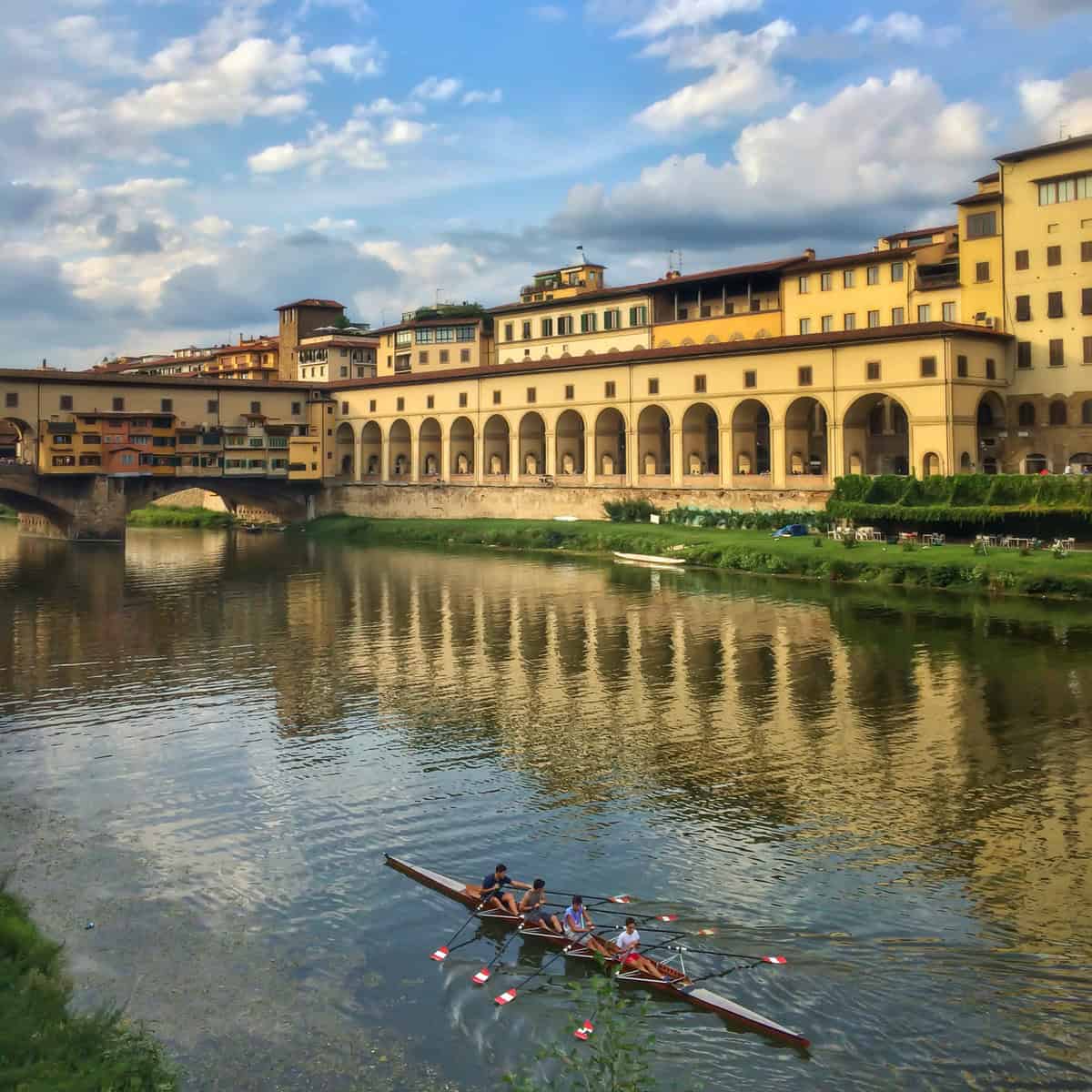
Florence, Italy: A Renaissance Gem
Florence, nestled in the picturesque hills of Tuscany, is a living museum where every corner tells a story. The city’s cobblestone streets invite you to wander through time, past stunning Renaissance architecture and grand piazzas.
The iconic Duomo punctuates Florence’s skyline; its red-tiled dome stands proudly as a symbol of the city’s artistic legacy. Home to masterpieces by Michelangelo, Botticelli, and da Vinci, Florence’s museums and galleries are treasure troves of art and culture.
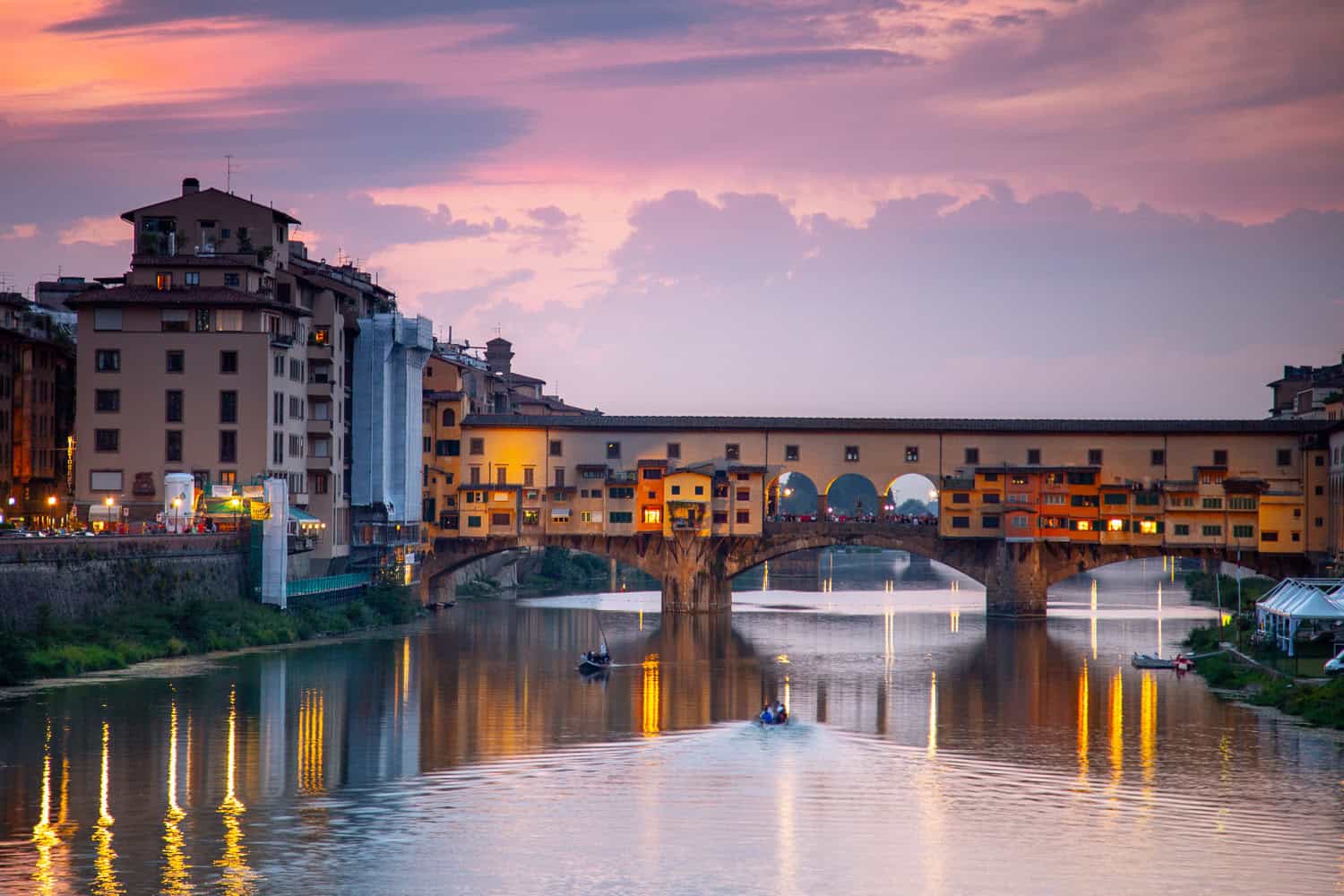
Practical Information
Best Time to Visit:
- Spring (April-May) and Autumn (September-October): These seasons offer pleasant weather, fewer crowds, and lower prices than summer, perhaps making it the best time to visit Florence.
- Summer (June-August): While it’s the busiest time, Florence is still beautiful in the summer. Be prepared for crowds and higher prices.
- Winter (December-February): The city is less crowded in winter, and you might even catch a glimpse of snowfall. However, some attractions and restaurants may have limited hours.
Transportation:
Florence is a pedestrian’s dream, with its charming cobblestone streets making walking the best way to explore the historic centre.
For longer distances, the city’s bus system offers an efficient and affordable alternative, with routes covering most major attractions and neighbourhoods. Buses are frequent and reasonably priced, making them a convenient choice for travellers exploring more of Florence without breaking the bank.
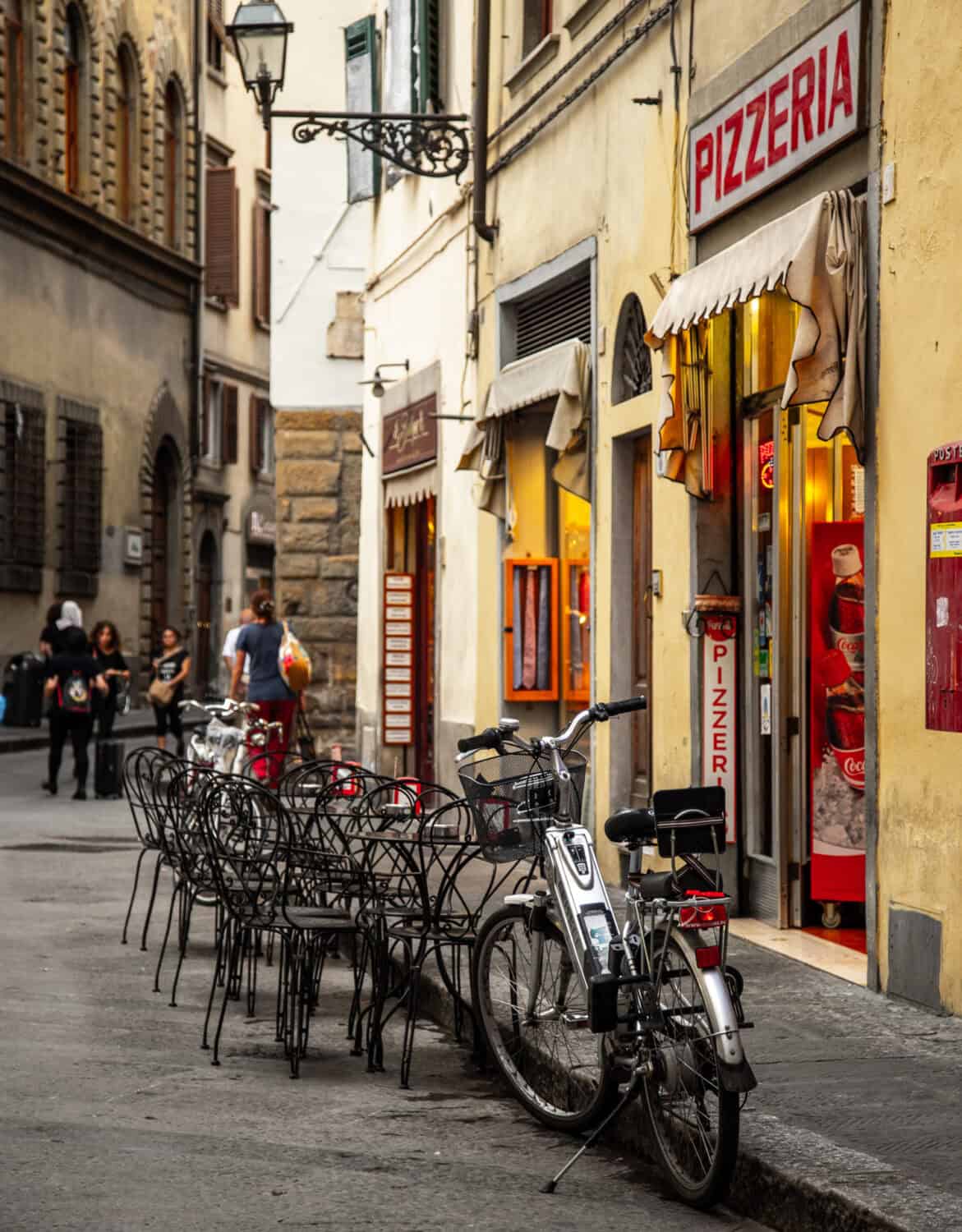
Taxis are also available throughout the city, but they can be pricey, so they’re best reserved for late-night returns or only when you’re in a hurry.
Tips:
- Wear comfortable shoes: You’ll be doing a lot of walking, so make sure you have comfortable footwear.
- Use public transportation: Florence has almost 100 bus lines, 3 active tram lines, and a special night service, making it very well connected.
- Purchase a Firenze Card: The Firenze Card is your cultural fast pass to Florence’s best attractions. This card gives you priority access to over 70 museums, galleries, and historical sites in the city, such as the Uffizi Gallery and the Accademia. The card is valid for 72 hours, making it ideal for short visits. It also offers discounts on public transportation.
- Avoid driving: The city’s ZTL (Limited Traffic Zone) is confusing and restricted, so driving is best left to locals.
- Purchase tickets online: For popular attractions like the Uffizi and Duomo, buy tickets in advance to avoid long lines (see our recommendations below).
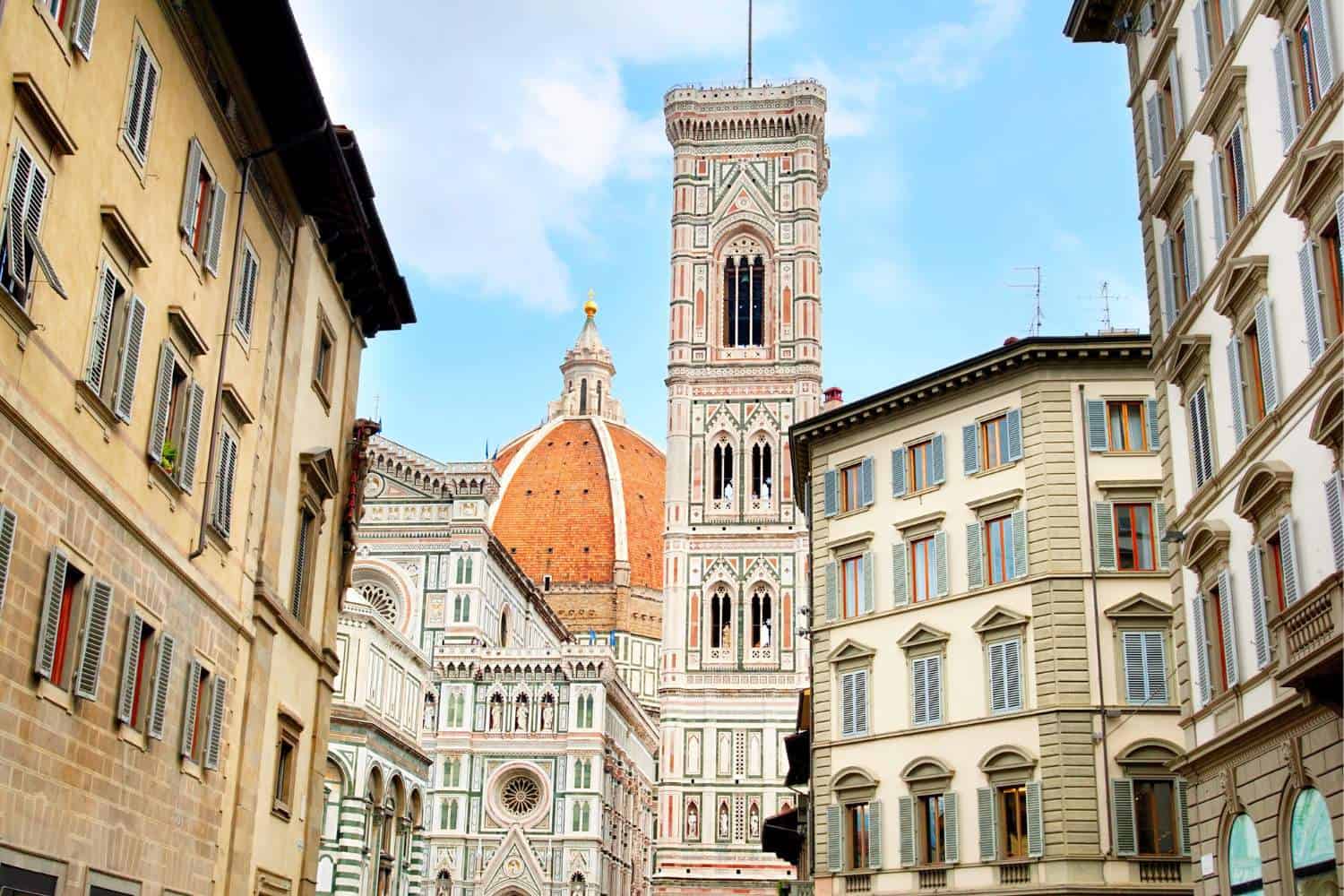
Best Things to Do and See in Florence
Uffizi Gallery
A masterpiece of Italian Renaissance art, the Uffizi houses an unparalleled collection of paintings by Botticelli, Michelangelo, and Leonardo da Vinci.
- Best Time to Visit: Early mornings or late afternoons to avoid crowds, particularly on weekdays.
- Hours: Tuesday to Sunday, 8:15 am–6:30 pm (9:30 pm on Tuesdays). Closed on Mondays.
- Tips: Book tickets in advance to skip long lines. Take breaks; the gallery is extensive, and there’s a lot to see.
- Transportation: Located centrally, the gallery is easily accessible on foot or by bus (ATAF buses #23, #C2).
- Tours: Tired of waiting in line? Expert guides will whisk you past the crowds and straight into the Uffizi Gallery. See Botticelli’s ‘Birth of Venus,’ Caravaggio’s ‘Medusa,’ and more hidden gems.
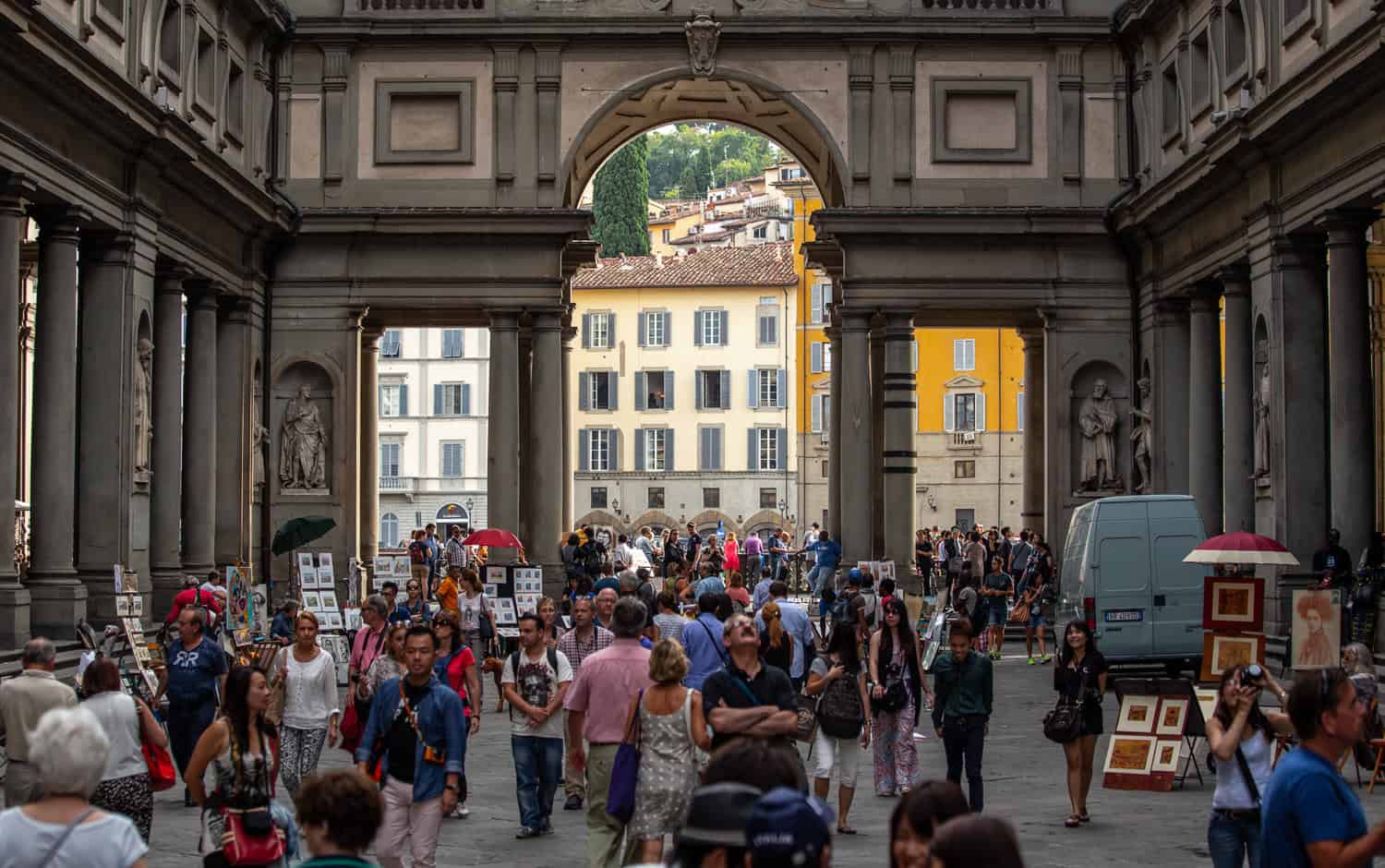
Duomo
The Cathedral of Santa Maria del Fiore, with its iconic Brunelleschi dome, is a symbol of the city’s architectural grandeur. It’s one of the stand-out buildings in the city and can be seen from almost every viewpoint. You can marvel at the exterior or book tickets and go inside.
- Best Time to Visit: Early mornings or late afternoons are best for avoiding long lines and large crowds. Weekdays are generally less crowded than weekends.
- Hours: The Cathedral is open from 10:15 am to 3:45 pm but closed on Sundays; Dome and Bell Tower from 8:15 am to 6:45 pm. Hours may vary, so check ahead, especially on holidays.
- Tips: Book tickets in advance for the Dome and Tower; wear appropriate clothing (shoulders and knees covered) for religious sites; and consider the Brunelleschi Pass for access to all areas.
- Transportation: Easily accessible by walking if you’re in the historic center; buses, taxis, and trams also serve the Piazza del Duomo area.
- Tours: We highly recommend avoiding the crowds and skipping the lines. With this Duomo and Brunelleschi tour, you’ll feel like a celebrity, leaving all those people lining up behind.
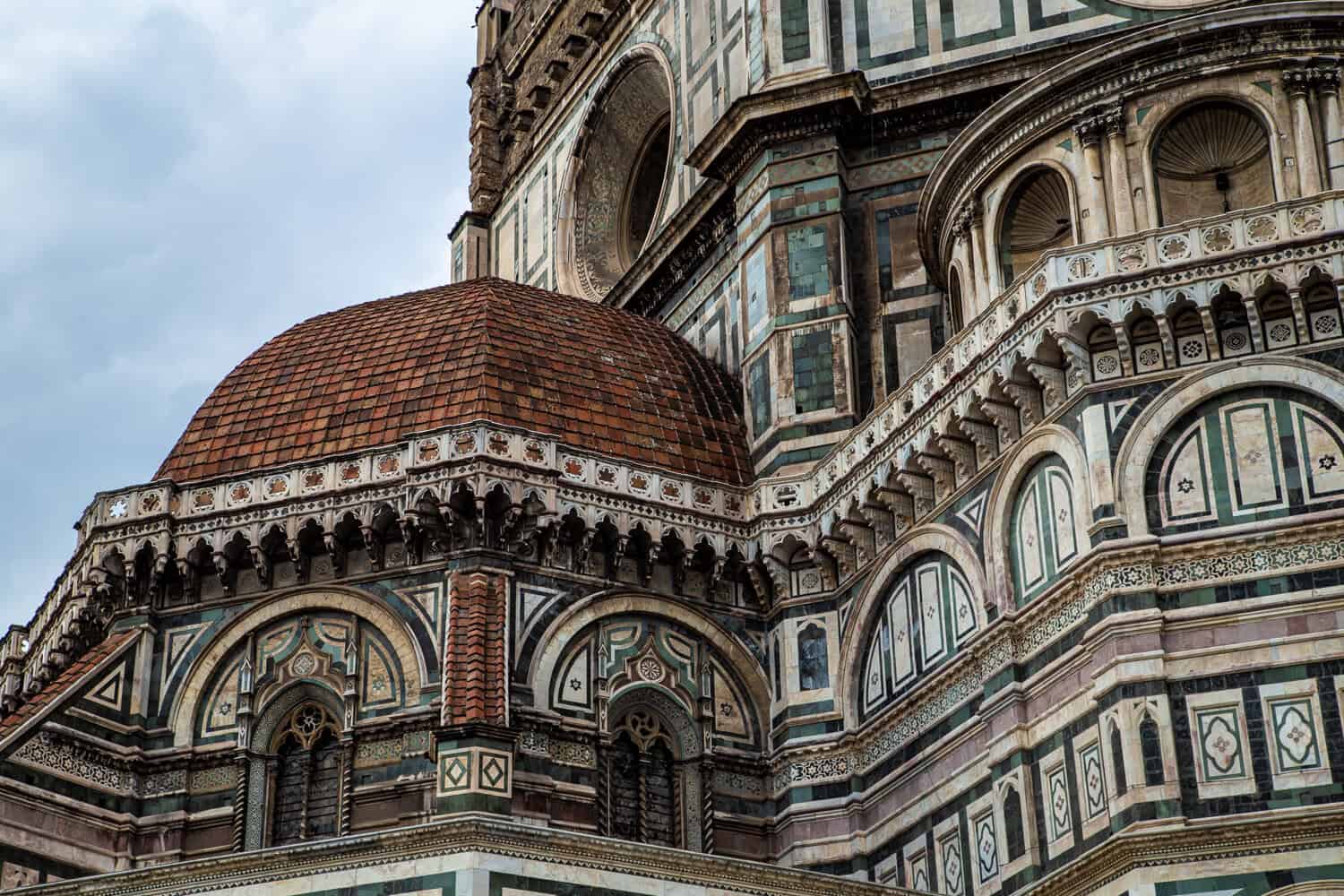
Ponte Vecchio
Ponte Vecchio is probably the most iconic medieval bridge and landmark in Florence. It’s lined with jewelry shops and offers stunning views of the Arno River and the surrounding city.
- Best Time to Visit: Visit early in the morning or late afternoon for fewer crowds and stunning sunset views, especially in spring and fall.
- Hours: Considering the bridge is a public walkway, it is open 24/7. The shops on the bridge typically are open from around 10:00 AM to 7:00 PM, depending on the season.
- Transportation: The Ponte Vecchio is centrally located and easily accessible by walking from most parts of Florence; buses and taxis are also available nearby.
- Tours: Many walking tours of Florence include the Ponte Vecchio, often combined with nearby landmarks like the Uffizi and Palazzo Pitti.
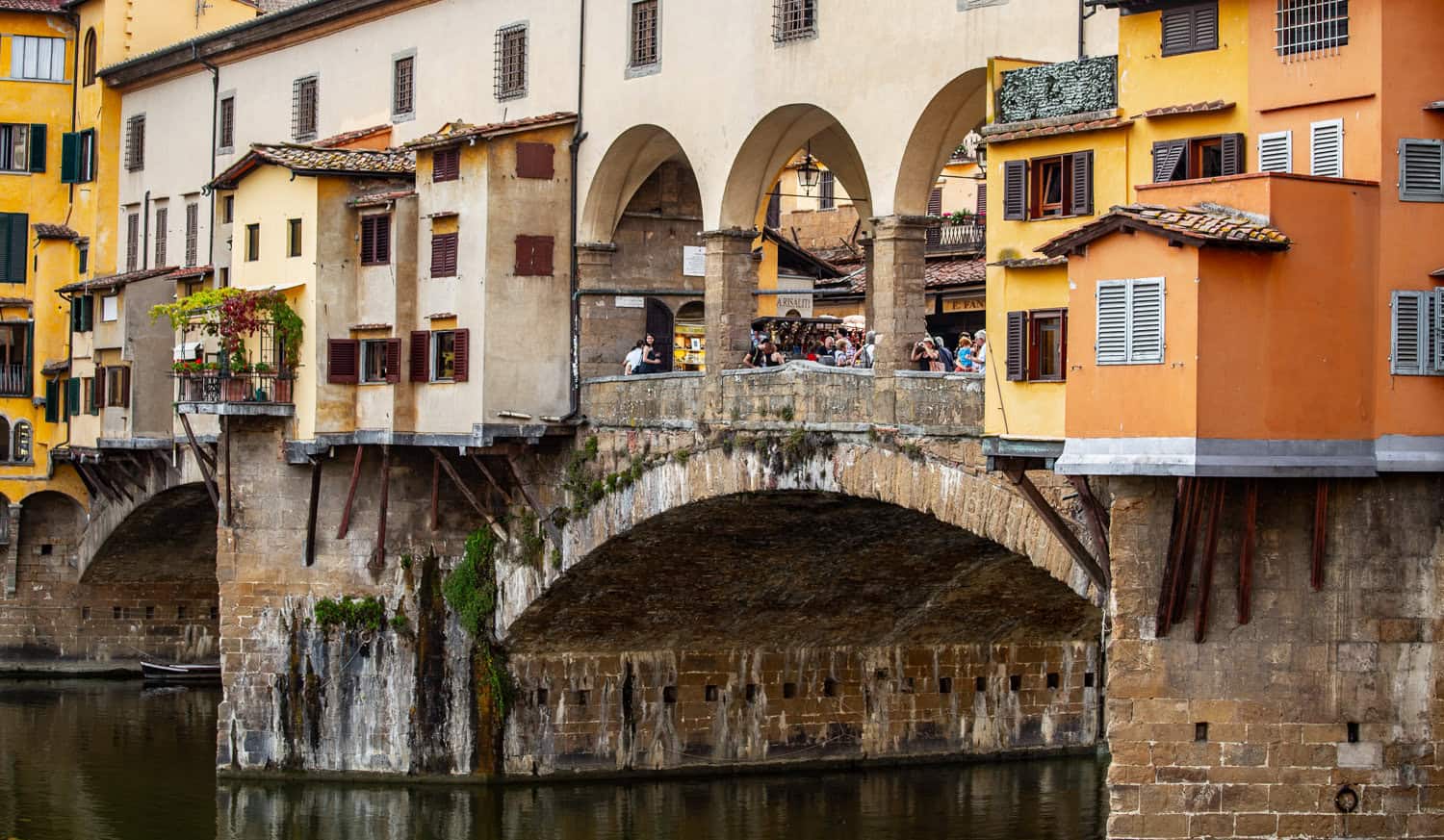
Palazzo Pitti
This grand palace, once the home of the Medici family, now houses a variety of museums, including the Palatine Gallery and the Boboli Gardens.
- Best Time to Visit: Visit during the morning in spring or fall to avoid large crowds and enjoy the Boboli Gardens in comfortable weather.
- Hours: The palace is typically open from 8:15 am to 6:30 pm but closed on Mondays; hours may vary for different museums within the complex.
- Tips: Buy tickets in advance, especially for the Boboli Gardens, and plan to spend several hours exploring the palace’s multiple museums and gardens.
- Transportation: Easily accessible by walking from central Florence; buses and taxis also serve the area near the palace.
- Tours: Guided tours cover the palace’s art collections and history, often including the Boboli Gardens, or you can opt for audio tours to explore at your own pace.
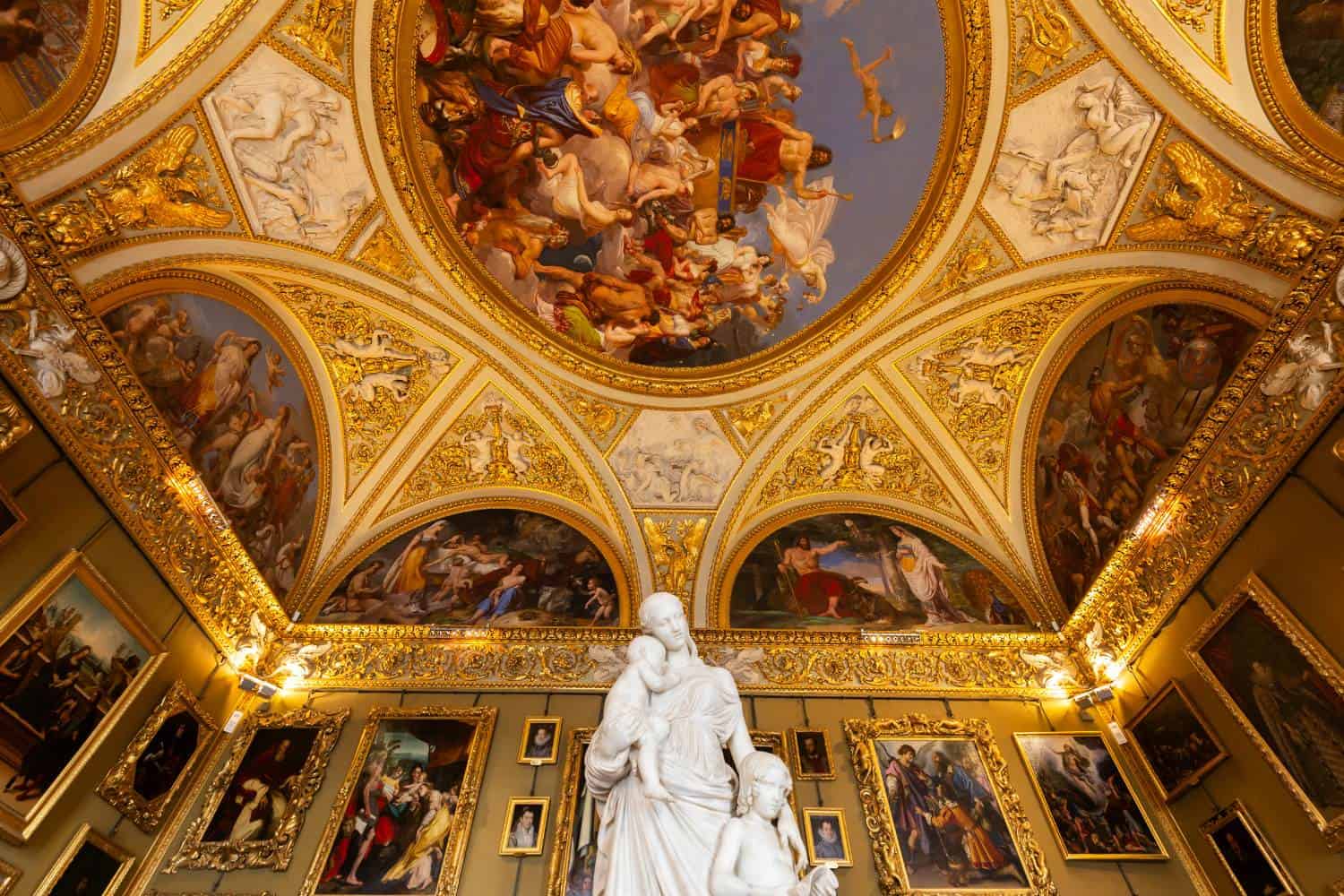
Piazzale Michelangelo
For an incredible view of Florence, including the Duomo, Ponte Vecchio and Palazzo Vecchio, this is where you want to be, especially at sunset. It’s very popular amongst visitors and locals, so be prepared for some crowds. The square is dominated by a bronze replica of Michelangelo’s David, standing as a tribute to the artist.
- Best Time to Visit: Visit at sunrise or sunset for breathtaking panoramic views of Florence, with spring and fall offering the best weather.
- Hours: The Piazzale is open 24/7 as a public space, making it accessible at any time of day.
- Tips: Bring a camera for stunning photos, and consider packing a snack or drink to enjoy while taking in the view.
- Transportation: Reach the Piazzale by walking, taking bus routes 12 or 13, or using a taxi; it’s about a 20-minute uphill walk from the city center.
- Tours: Many walking and bike tours include Piazzale Michelangelo, with some offering sunset tours for the best views of Florence.
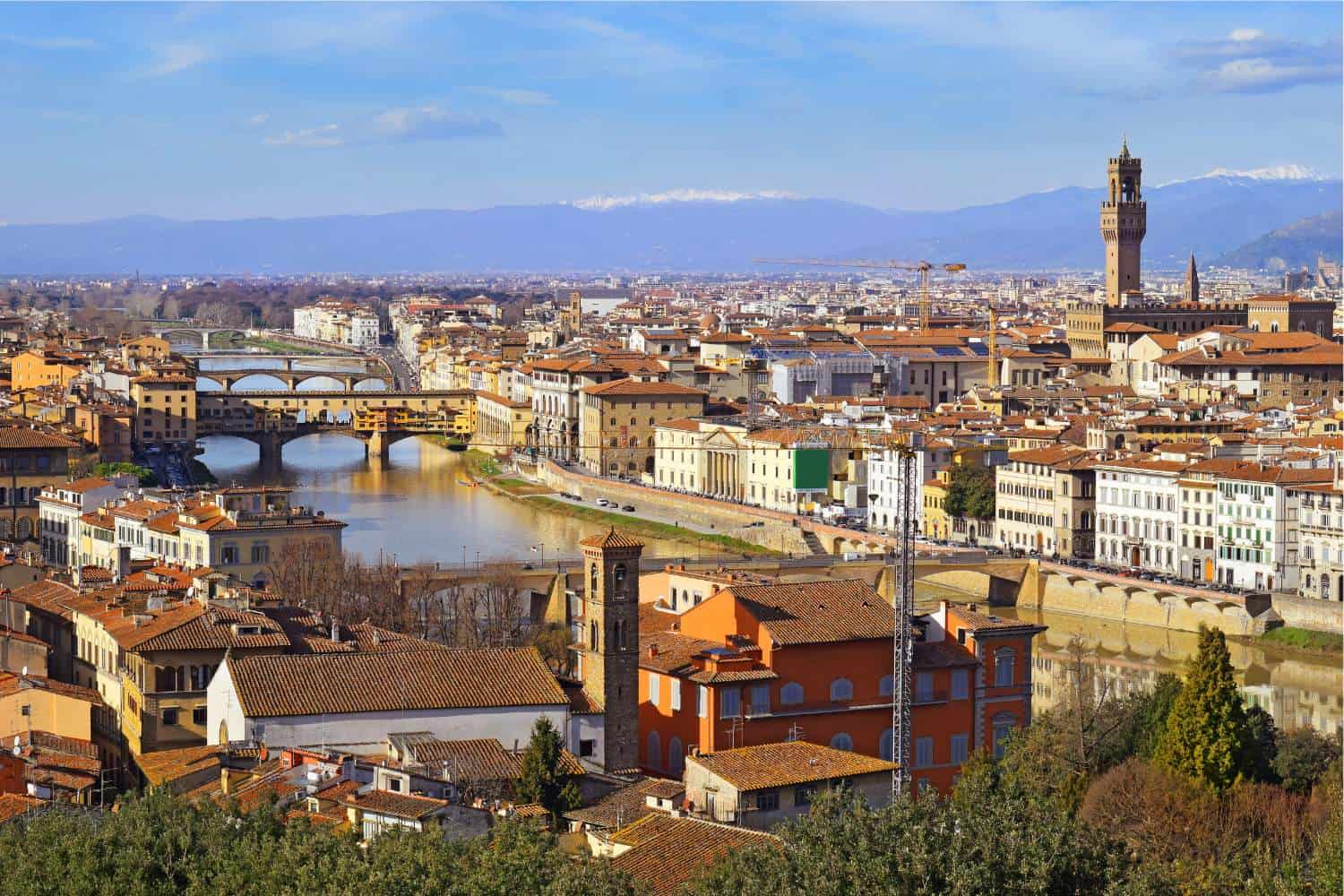
Unique Experiences
Market Shopping
Stroll through Florence’s lively markets, like the bustling Mercato Centrale, where every aisle offers a feast for the senses. Find fresh produce and sample lots of local delicacies. And it’s not just about the food—these markets are also treasure troves for unique souvenirs. Whether you’re hunting for artisanal olive oil, handmade pasta, or quirky keepsakes, the vibrant atmosphere ensures that every visit is a flavorful adventure.
Day Trips to the Tuscany Countryside
Tuscany serves up art, history, rolling hills, and mouthwatering cuisine in one perfect bite. Got just one day? No problem! Take a day trip from Florence and dive into the best of the region with a local guide. You’ll explore Siena’s medieval charm, enjoy (optional) wine tasting in Chianti, and stroll through the picturesque streets of San Gimignano. A trip to Pisa to gawk at the famous Leaning Tower is possible (although we honestly wouldn’t recommend it – the tower is genuinely not that exciting).
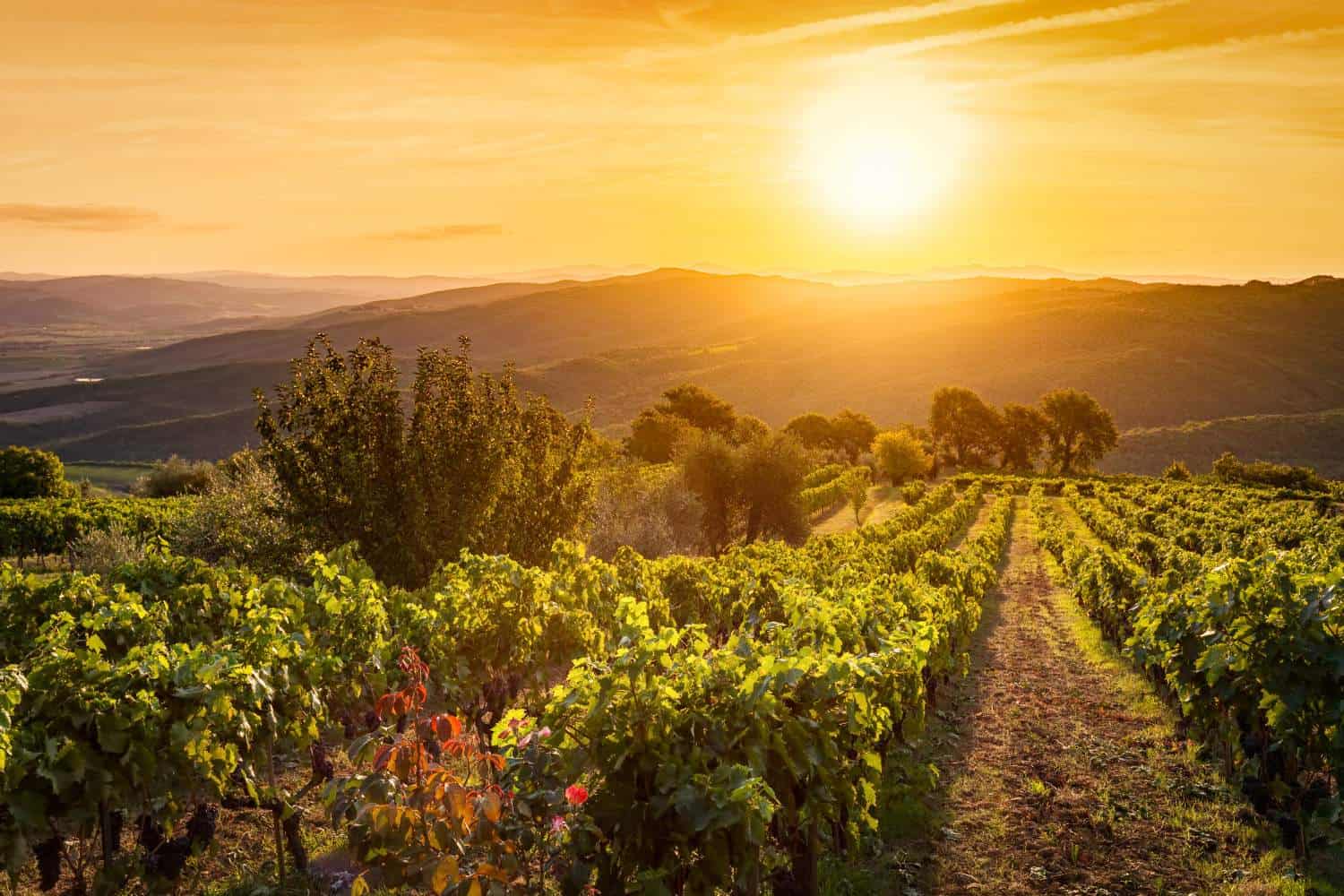
Take a Cooking Class
Unlock the mysteries of Tuscan cuisine by rolling up your sleeves and diving into a hands-on pasta and cooking class. Picture yourself in a cozy kitchen, surrounded by fresh local ingredients, as you learn to whip up dishes that would make any Italian nonna proud. From handmade pasta to rich, flavorful sauces, you’ll not only master the recipes but also pick up tips and tricks passed down through generations. And the best part? You get to savour the fruits of your labour, enjoying a delicious meal you created from scratch.
Art Workshop
Whether you’re an experienced artist or a beginner, a private workshop experience is designed to help you connect with Florence’s rich cradle of Renaissance art traditions. Rediscover your creative spark using Renaissance techniques and bring home not just a souvenir but an unforgettable memory.
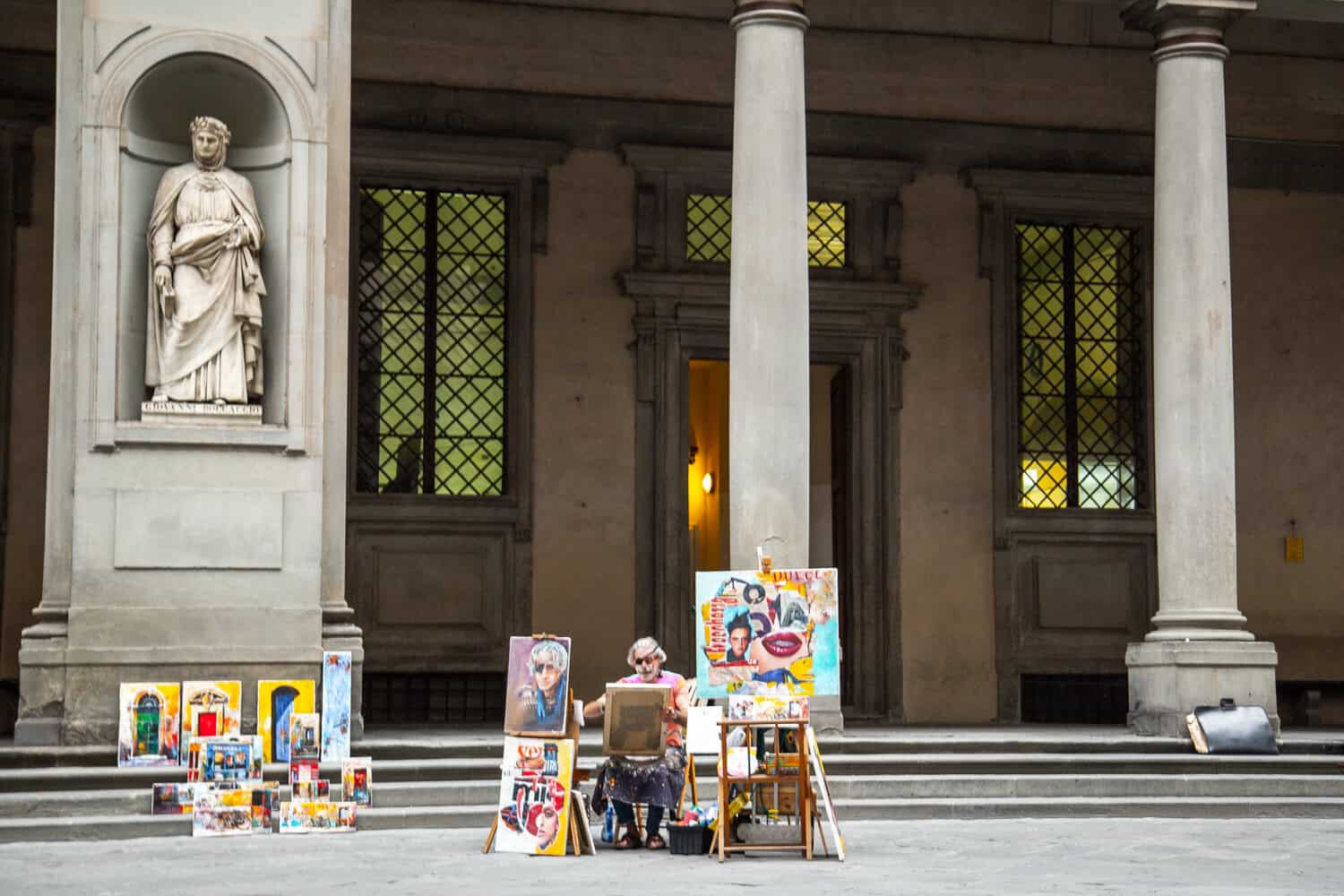
Florence Bike Tour
Florence is a treasure trove of jaw-dropping architecture, but let’s face it—strolling the cobblestone streets can leave you hobbling. Why not swap sore feet for two wheels? On a bike tour, you’ll glide through the city’s Renaissance core, hitting all the significant sights like the Duomo, Piazza Signoria, and Santa Croce without a single wrong turn. Best part? The tour wraps up with a well-deserved gelato break. No need for maps—just fun, history, and sweet rewards.
Florence From the Rooftops
Seeing Florence from the Rooftops offers the perfect blend of food, drinks, and sightseeing in Florence. Guests will visit historic bars with stunning views, learning about the city’s culture and history while sampling Italian “aperitivo,” wines, or a spritz (with non-alcoholic options for younger participants). For a morning option, indulge in an authentic Italian breakfast of cappuccino and cornetto. The experience wraps up with a delightful gelato.
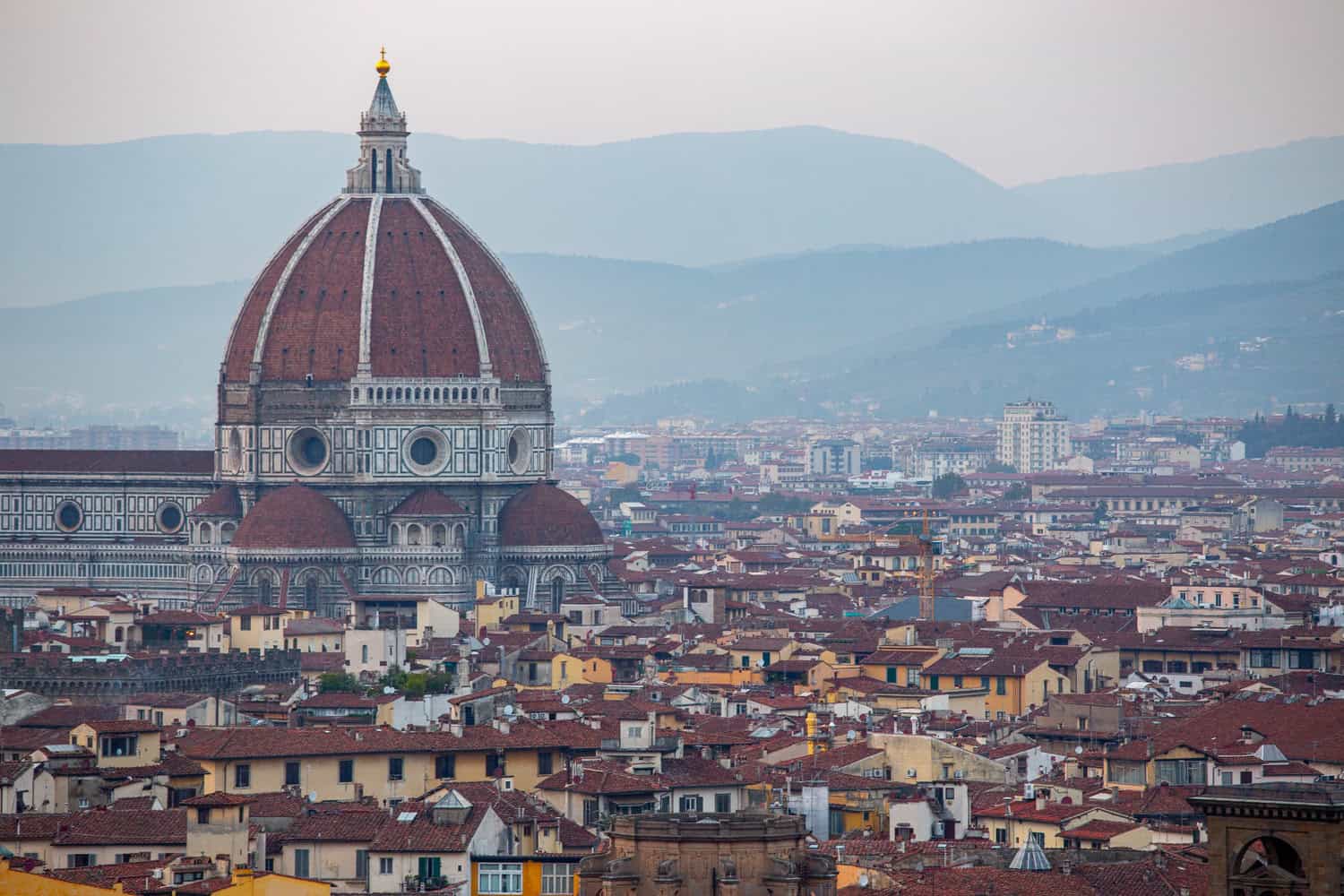
What and Where to Eat in Florence
Florence is renowned for its delicious Italian cuisine and traditional Tuscan dishes. Here are a few must-try dishes:
- Bistecca Fiorentina: A juicy, grilled T-bone steak, typically served with a side of potatoes.
- Pappa al Pomodoro: A hearty Tuscan soup made with bread, tomatoes, and basil.
- Gelato: Indulge in the creamy, flavorful gelato found on every corner of the city.
- Chianti wine: Sample the famous Chianti wine produced in the surrounding Tuscan countryside.
- Porchetta – A delectable Italian dish that’s sure to tantalize your taste buds. It’s essentially a boneless pork roast that’s been stuffed with aromatic herbs and spices, such as rosemary, garlic, and fennel. The pork is then slow-roasted until the skin is crispy and the meat is incredibly tender and juicy.
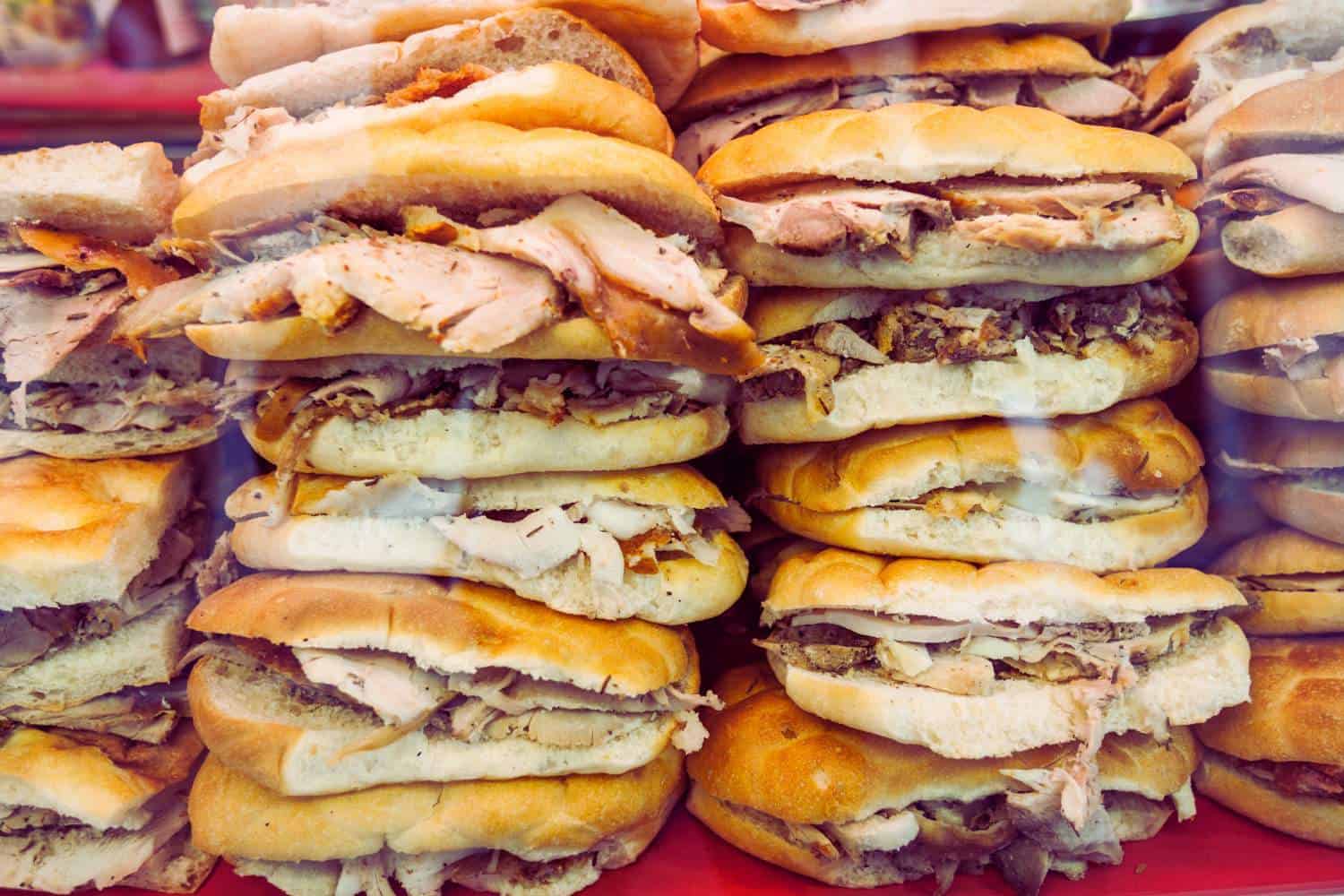
- Osteria Santo Spirito: This charming trattoria is located in the Oltrarno district and is known for its authentic Tuscan dishes. Their pasta dishes, especially the Pappardelle al Cinghiale (wild boar pasta), are particularly popular.
- Trattoria Mario: A family-run establishment since 1898, Trattoria Mario is a must-visit for traditional Florentine cuisine. Their Bistecca alla Fiorentina (Florentine steak) is a local favorite, and their friendly atmosphere makes it a memorable dining experience.
- All’Antico Vinaio: This popular sandwich shop offers delicious and affordable paninis stuffed with high-quality meats, cheeses, and vegetables. Their sandwiches are so popular that there’s often a line out the door! We’ve been there several times and salivate every time we even think about it.
- Le Volpi e le Uve: This stylish restaurant is located in the historic center of Florence and offers a modern take on Tuscan cuisine. Their innovative dishes and elegant ambiance make it a popular choice for a special occasion.
- Gelateria Santa Cristina: For a sweet treat, head to Gelateria Santa Cristina, a renowned gelato shop known for its creamy and flavorful ice cream. With a wide variety of flavours, there’s something for everyone to enjoy.
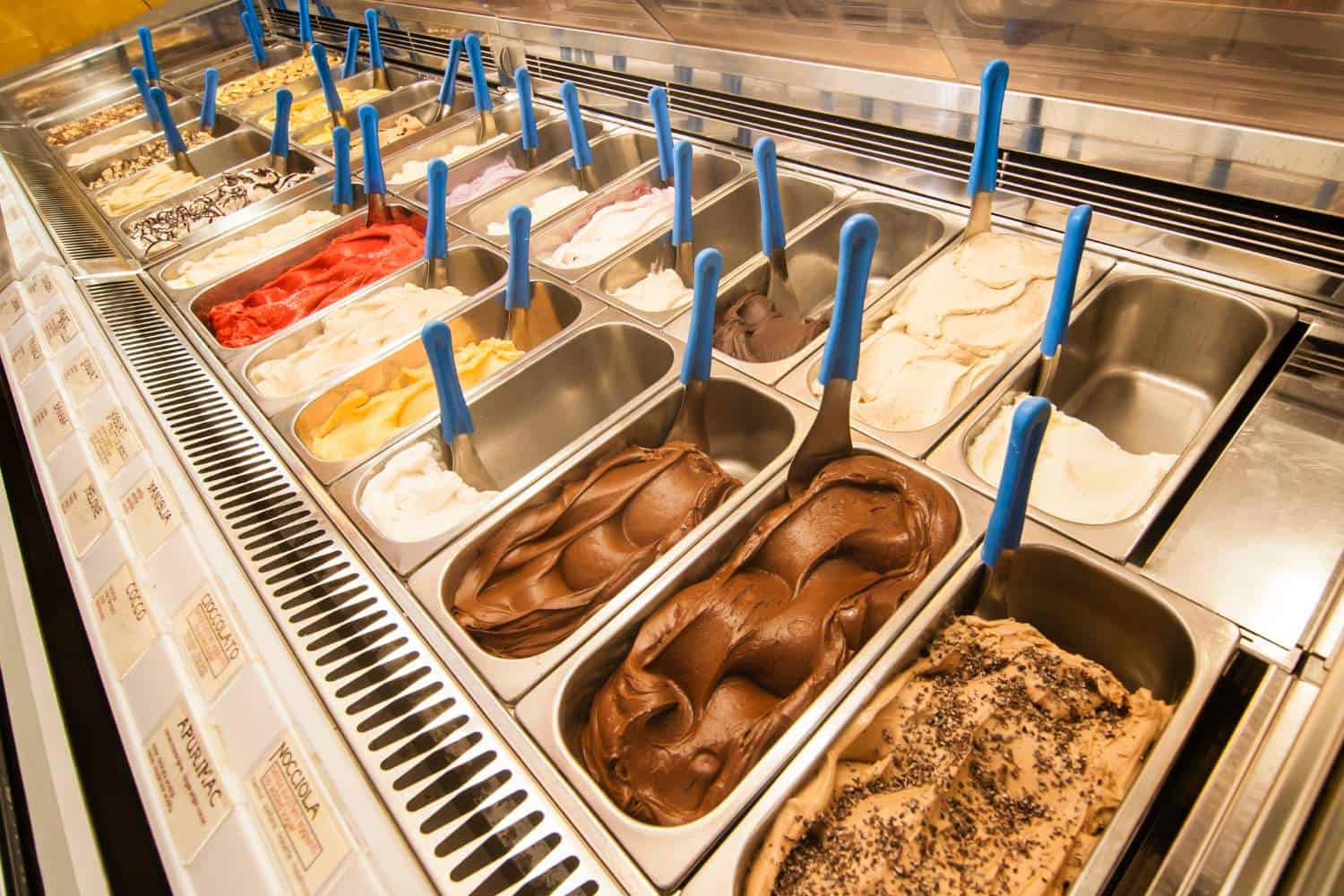
Where to Stay in Florence
Florence offers a variety of accommodation options to suit every budget. Consider staying in the historic center for easy access to the city’s attractions. Some popular neighbourhoods include Santa Croce, San Niccolò, and Oltrarno.
Rocco Forte Hotel Savoy
If you want to splurge on a stay in Florence, this is where you want to stay. Rocco Forte Hotel Savoy is a historic luxury hotel in the heart of Florence, offering elegant accommodations and impeccable service. The hotel’s modern Art Nouveau decor, Michelin-starred restaurant, and a rooftop terrace with panoramic city views make it a top choice for discerning travellers.
Brunelleschi Hotel
Situated in a 15th-century tower in the heart of the city, Brunelleschi Boutique hotel boasts stunning views of the Duomo and the entire city. The hotel’s elegant rooms, rooftop terrace, and excellent service make it a popular choice for both couples and families.
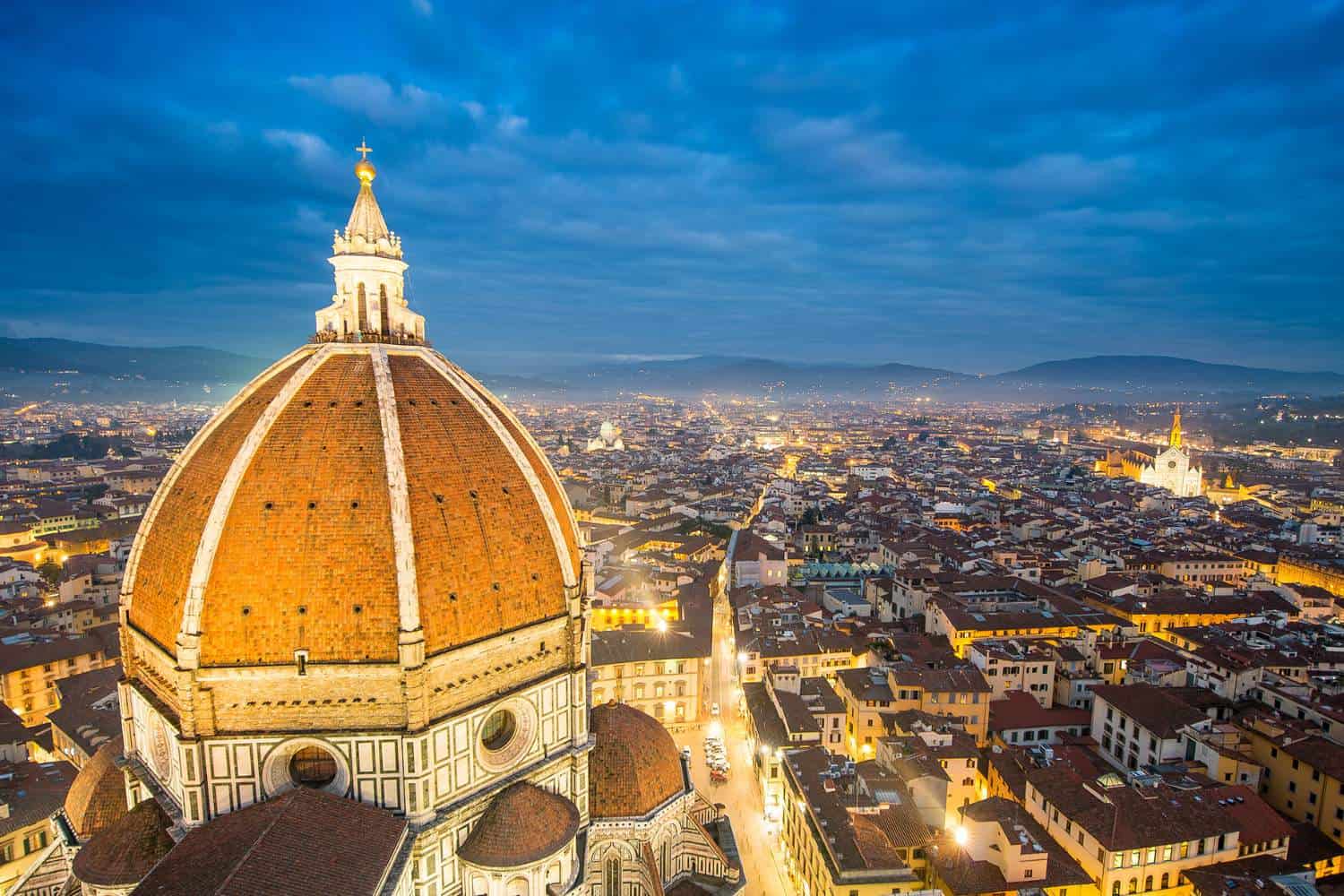
Hotel Lungarno
Overlooking the Arno River, Hotel Lungarno is a luxury hotel offering stylish accommodations and panoramic city views. Guests are pampered here with the hotel’s spa, a Michelin-starred restaurant, and a convenient location. This hotel easily is a top choice for those seeking a luxurious stay in Florence.
J.K. Place
The Place Firenze is a charming boutique hotel located in a historic building in the Oltrarno district. The hotel’s cozy rooms, friendly staff, and affordable rates make it a great option for those who travel on a budget and who want to experience the authentic side of Florence. But good luck getting a room here. Reservations book up fast and well in advance. If you do manage to get a room, enjoy it!
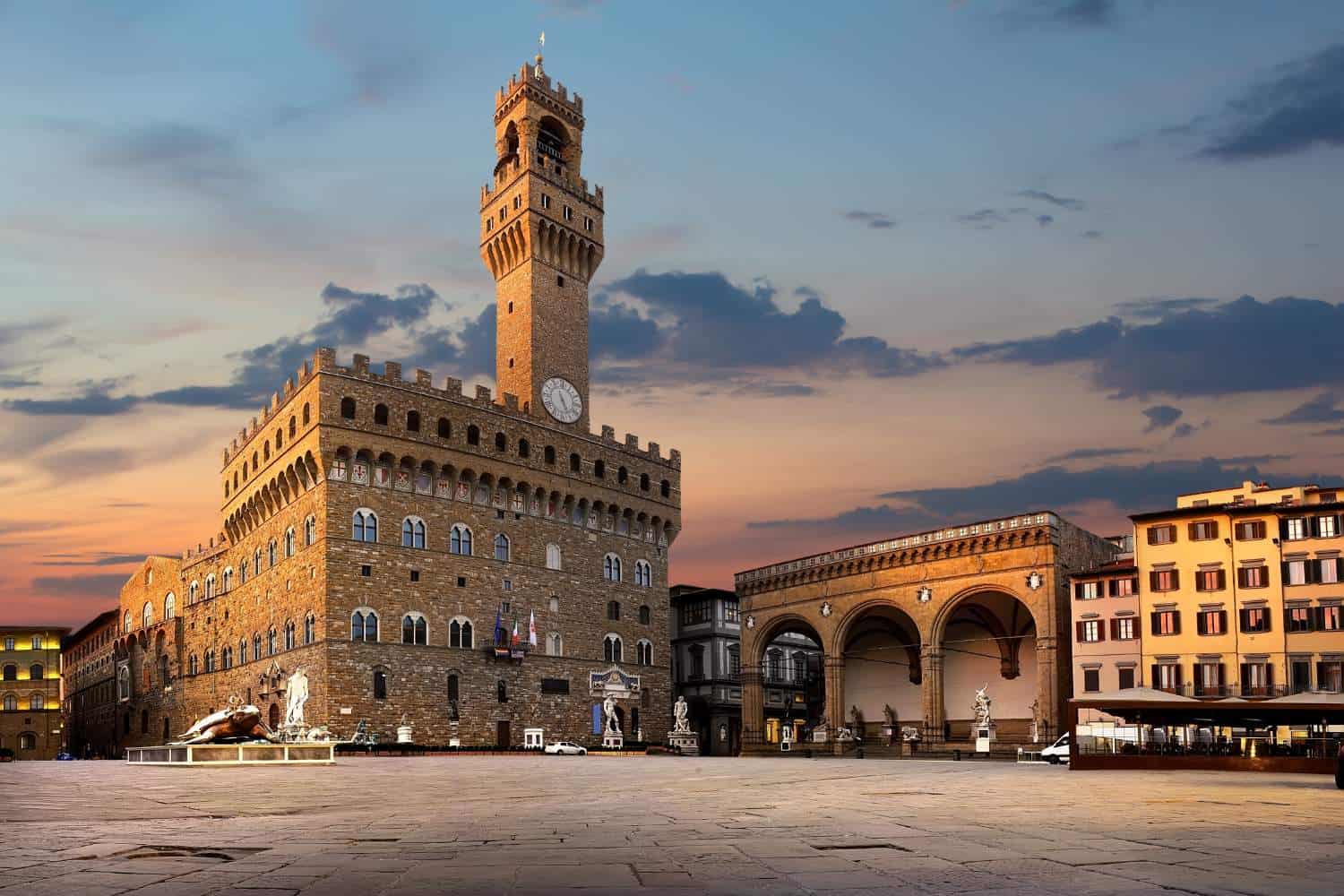
Venice, Italy: A Floating City of Romance
Venice, the city of canals, offers an open invitation to get delightfully lost. Imagine wandering through its labyrinth of narrow alleys and crossing charming stone bridges, with every turn offering a glimpse of something enchanting. Honestly, getting lost is a big part of Venice’s appeal. (So much so that we even considered what it might be like to live in Venice.)
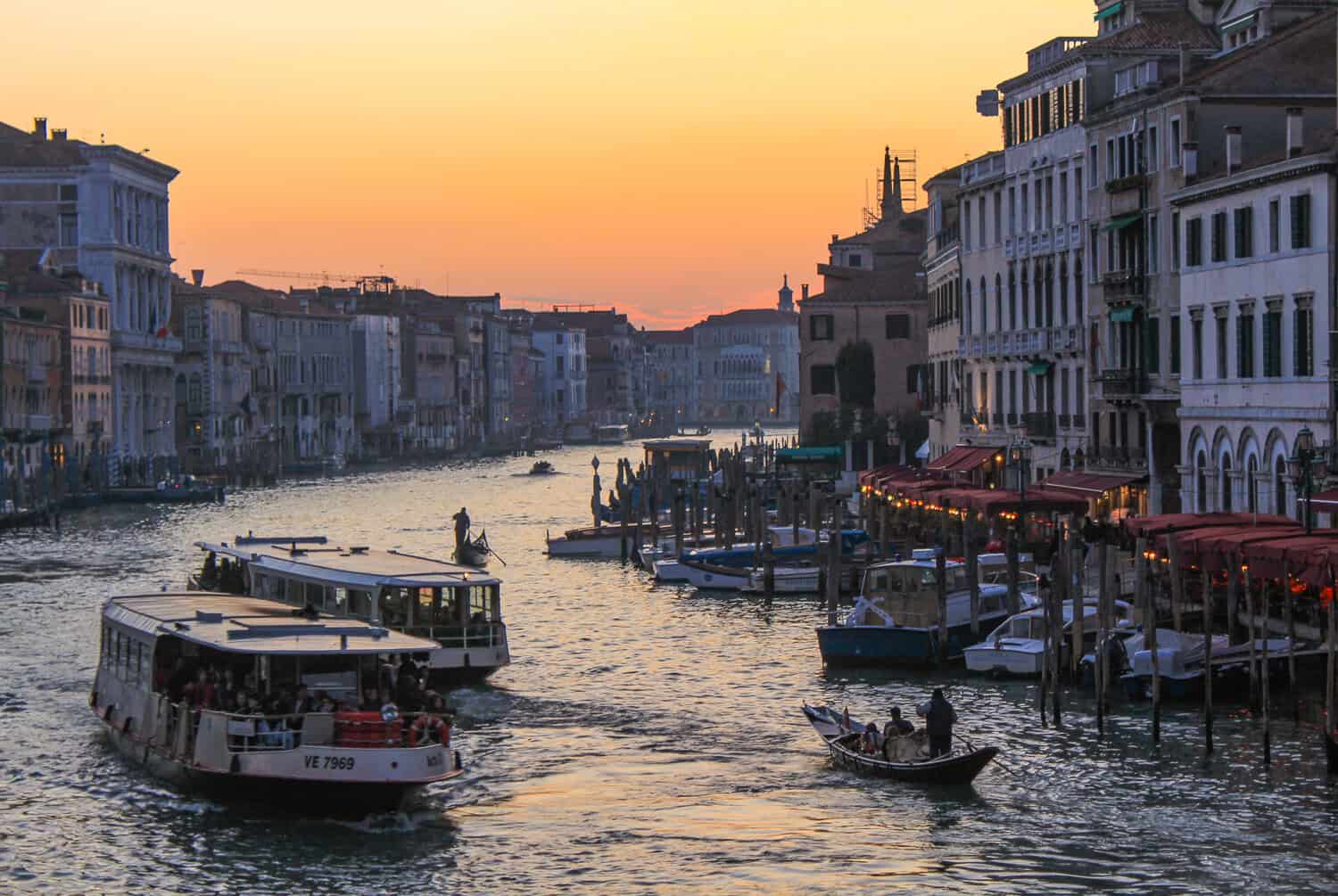
Practical Information
Best Time to Visit:
- Spring (April-May) and Autumn (September-October): These seasons offer pleasant weather, fewer crowds, and lower prices than summer, perhaps making it the best time to visit Venice.
- Summer (June-August): While it’s the busiest time, Venice is still magical in the summer. Be prepared for crowds and higher prices.
- Winter (December-February): The city is less crowded in winter, and you might even catch a glimpse of snowfall. However, some attractions and restaurants may have limited hours.
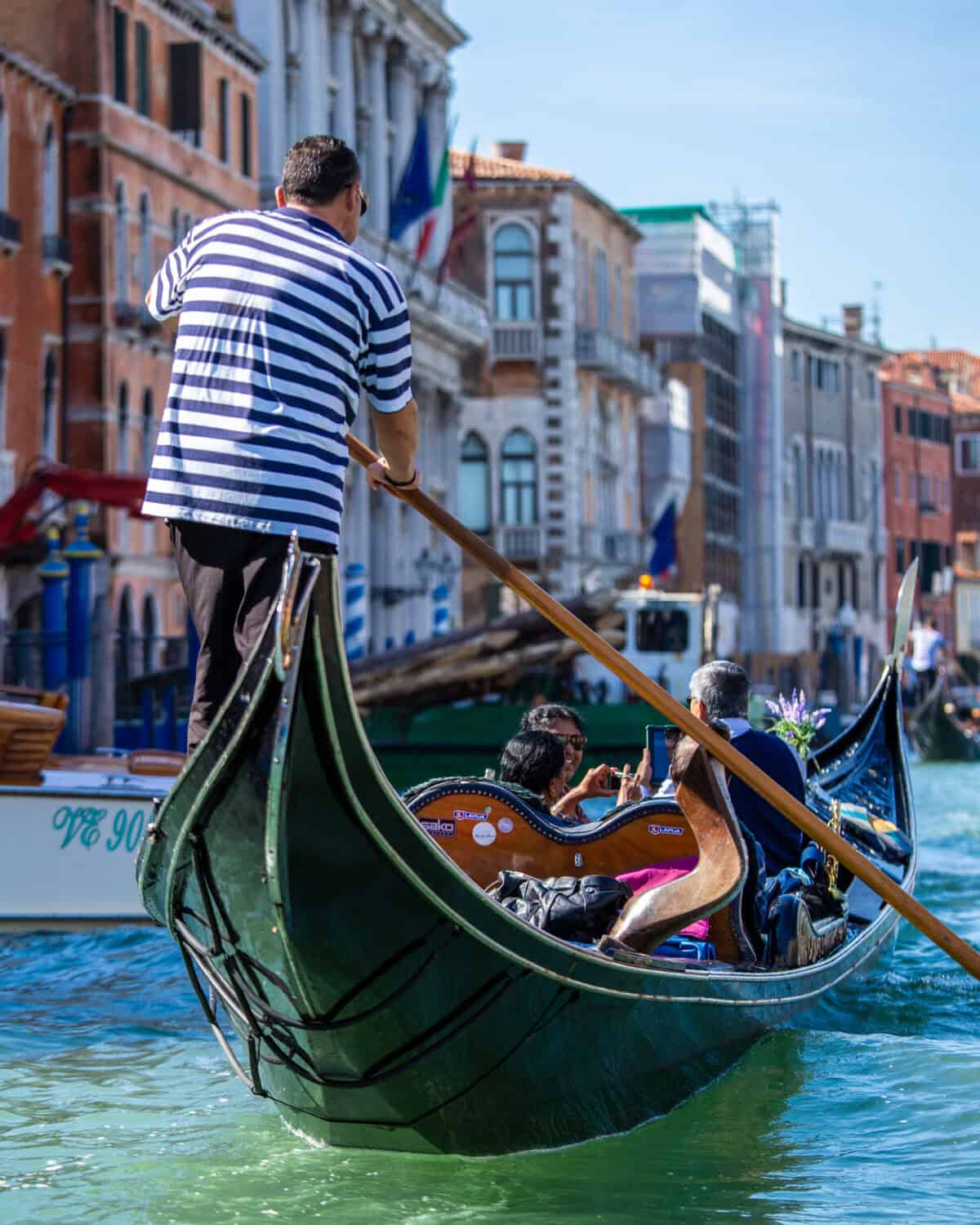
Transportation:
- Water Bus (Vaporetto): The Vaporetto is Venice’s answer to a city bus, but with a twist—you’re cruising the iconic canals instead of fighting traffic. Getting around the city by boat is the most convenient way to navigate Venice’s watery streets. Grab yourself a Vaporetto pass, and you can hop on and off these floating ferries as often as you like. Whether you’re headed to the Rialto Bridge or just looking for the next gelato stop, a Vaporetto pass ensures you’ll travel like a local–without sinking your wallet.
- Gondola: Sure, a gondola ride in Venice might cost you more than a slice of pizza, but let’s be honest—can you really say you’ve experienced Venice without lounging in a gondola while a striped-shirt gondolier serenades you under the moonlight? It’s like eating spaghetti without the meatballs! Yes, it’s a bit of a splurge, but it’s also the most iconic way to see Venice’s magical canals. Think of it as an investment in a memory that’s worth more than a thousand Instagram likes.
- Walking: Venice practically begs to be explored on foot, with its labyrinth of narrow streets, secret squares, and charming bridges. You’ll stumble upon hidden gems like quaint cafes, quirky shops, and tiny canals that the tourists haven’t discovered yet. Each twist and turn reveals another postcard-worthy view, and who knows? You might even accidentally wander into the perfect little trattoria for a spontaneous lunch. So, lace up your comfiest shoes and let Venice’s maze lead you to unexpected adventures.
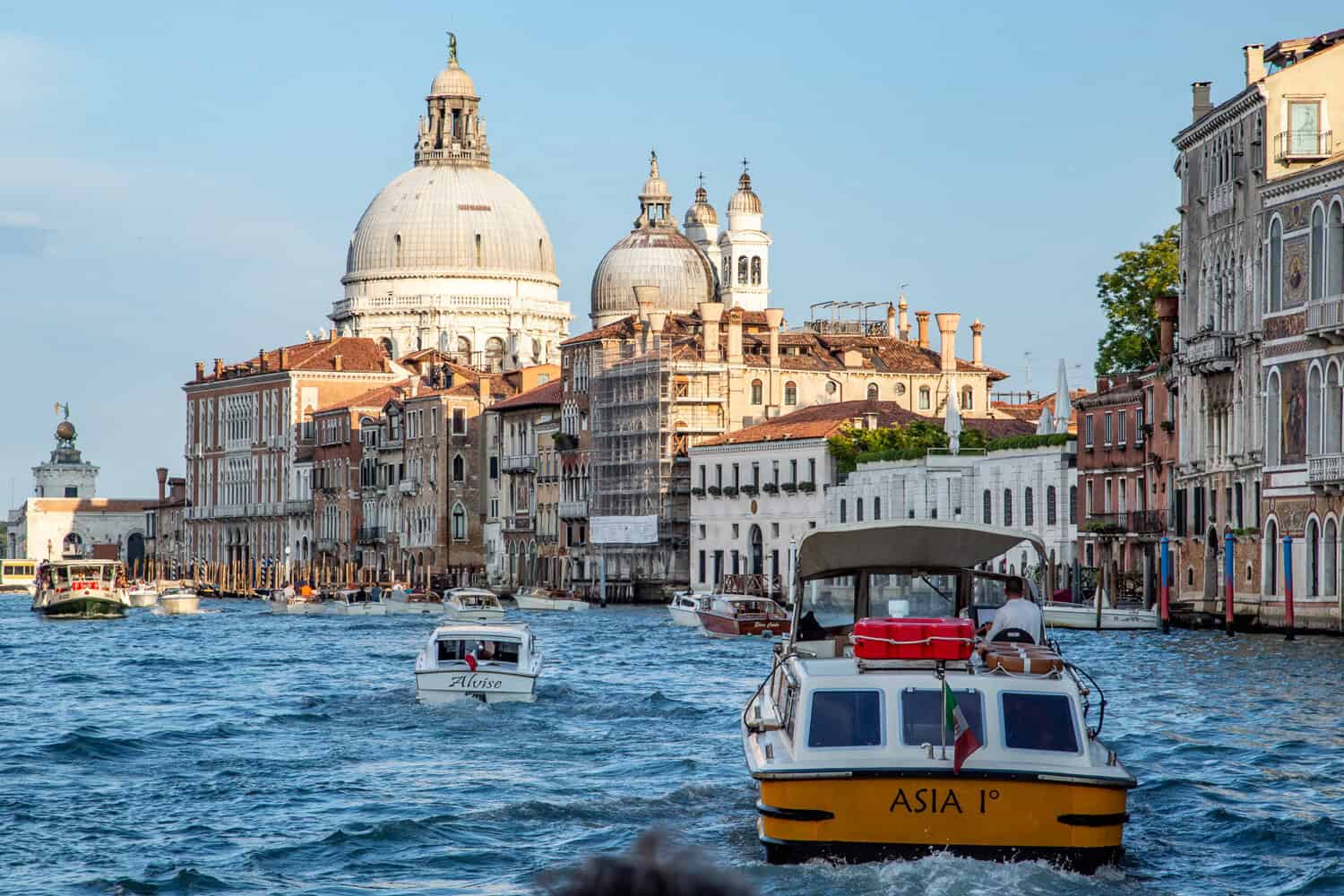
Tips:
- Wear comfortable shoes: You’ll be doing a lot of walking, so make sure you have comfortable footwear.
- Be patient: Venice can get crowded, especially during peak season.
- Tourist Day Tax – Starting in 2025, tourists who arrive in Venice only for the day will be required to pay a daily tourist tax. The ticket must be paid for in advance, and a QR code will be supplied. There will be no turnstiles to present the ticket, but there will be random checks to ensure people have them. The tax is expected to be between 3 and 10 Euros. If you spend one or more nights in Venice, the tax is included in your accommodation stay.
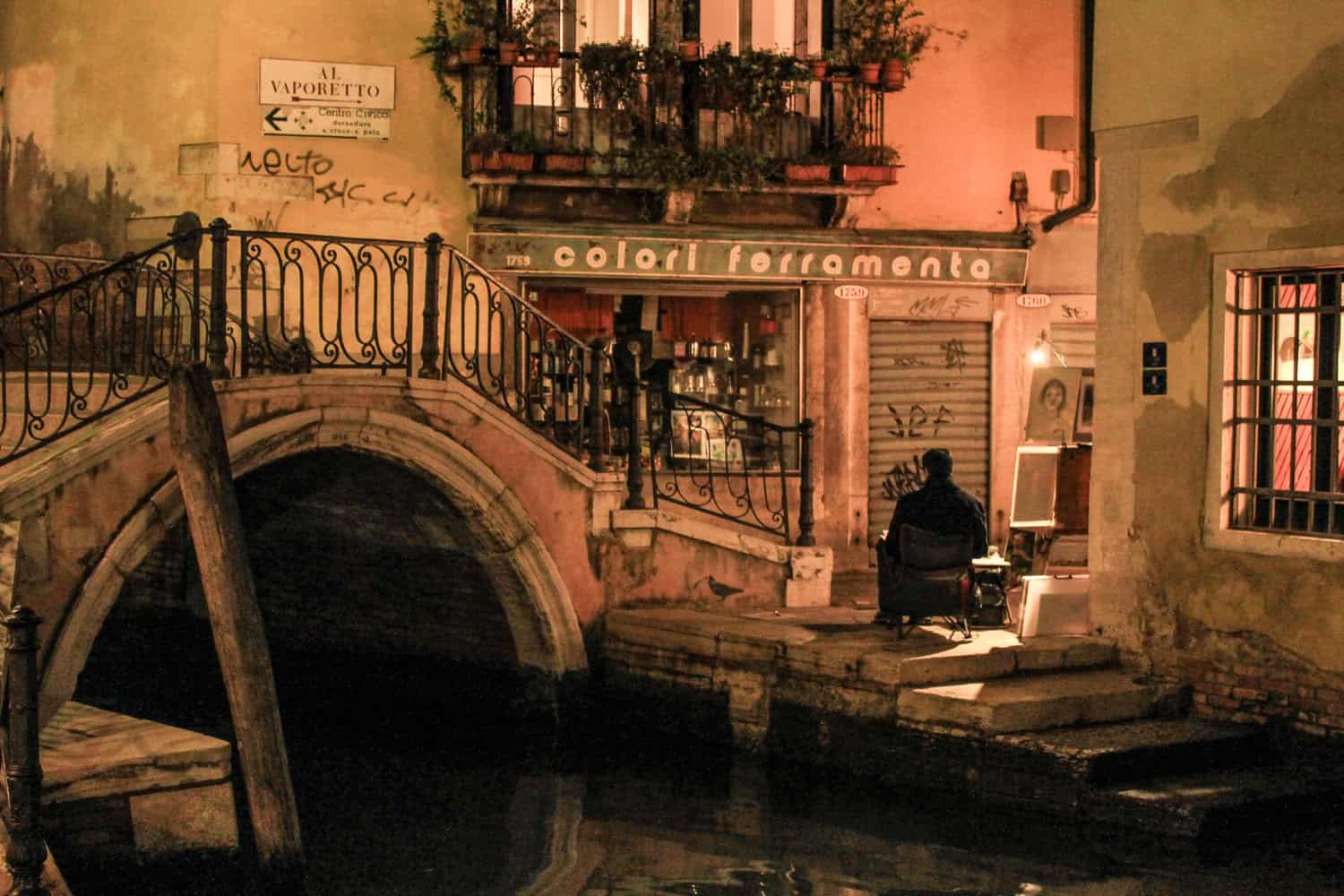
Best Things to See and Do in Venice
Piazza San Marco (St. Mark’s Square)
Welcome to Piazza San Marco, the beating heart of Venice, where history, art, and a few hundred pigeons collide. This iconic square is home to the magnificent St. Mark’s Basilica, where every inch seems to be covered in glittering mosaics. Don’t forget to look up at the Campanile bell tower—climb it for panoramic views of the city.
- Best Time to Visit: Early morning to beat the crowds or late at night when the square is beautifully lit and less crowded.
- Hours: Open 24/7, though specific attractions within the square, like St. Mark’s Basilica, have set hours.
- Tips: Watch for high tides that can flood the square, especially in autumn and winter. Enjoy a coffee at one of the historic cafes, but be prepared for steep prices.
- Transportation: Easily accessible by Vaporetto to the San Marco stop.
- Tours: There are a variety of guided tours that include St. Mark’s, often bundled with entry to St. Mark’s Basilica and the Doge’s Palace.
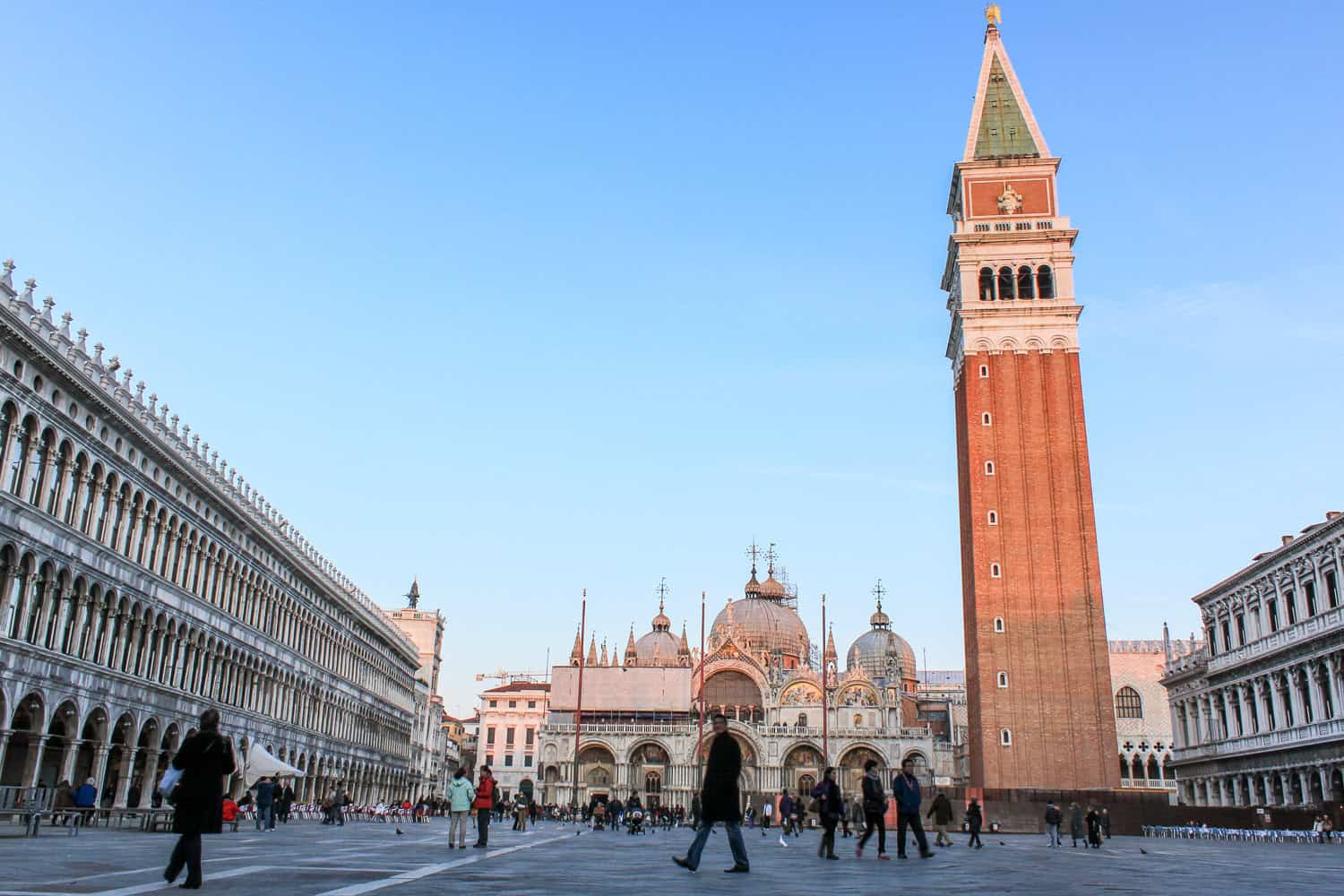
Rialto Bridge
Ah, the Rialto Bridge—a true Venetian icon. Built in the late 16th century, it’s not just one of the oldest bridges in Venice but also the most famous tourist attraction. Spanning the Grand Canal with a grace that only centuries of history can muster, it offers stunning views that are postcard-perfect from every angle. As you cross its stone arches, you’ll find shops lining the way, offering everything from jewelry to souvenirs. Stop, take the view, and watch as gondolas glide beneath you.
- Best Time to Visit: Early morning for fewer crowds or at dusk for a stunning sunset view.
- Hours: Open 24/7 as it’s part of the main pedestrian route.
- Tips: Visit the nearby Rialto Market in the morning to experience local culture. Hold onto your wallet—this area is notorious for pickpockets.
- Transportation: Accessible by Vaporetto lines 1 and 2, stopping at the Rialto stop.
- Tours: Most walking tours of Venice include a visit to the Rialto Bridge, offering insights into its history and significance.
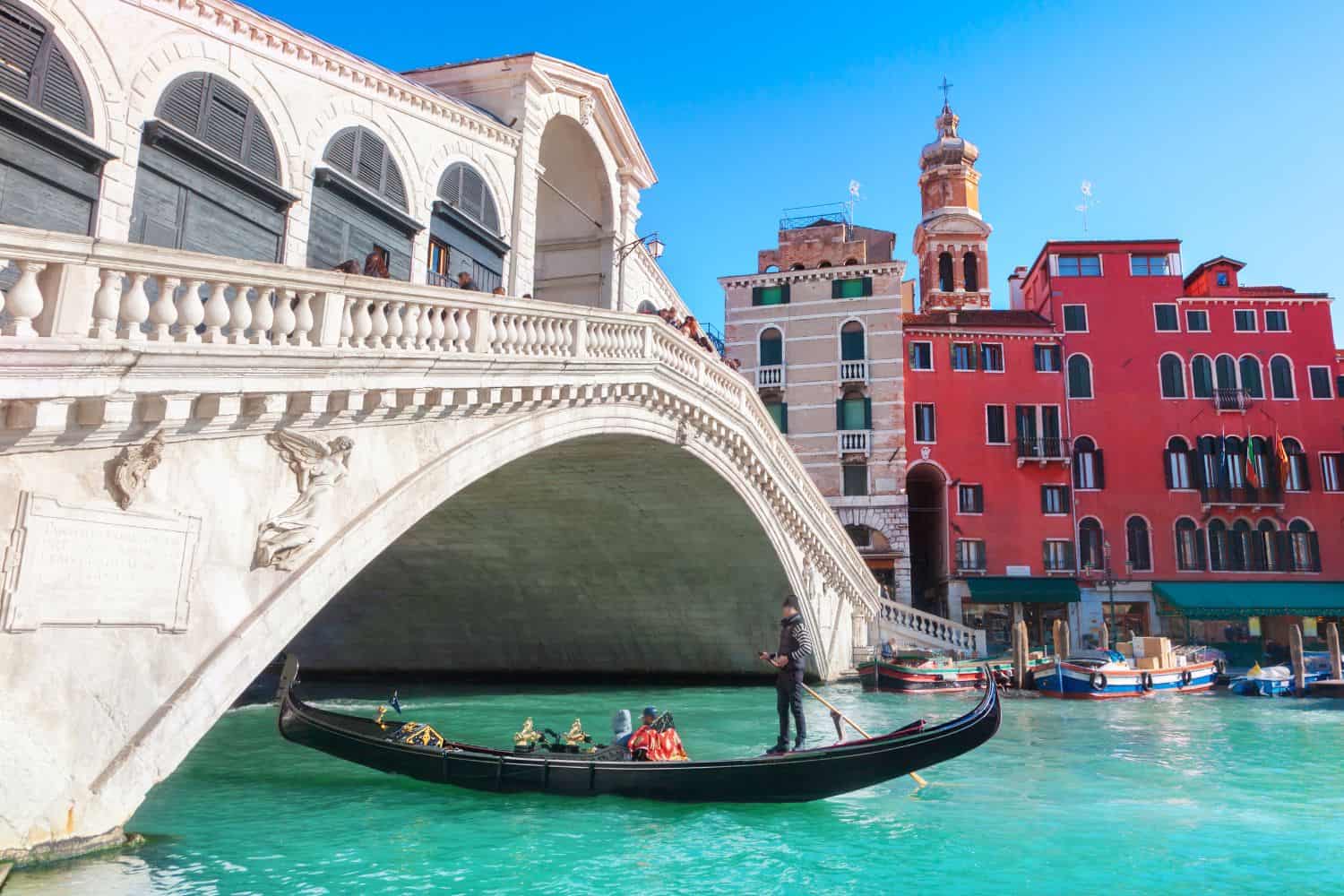
Hop on a Gondola Ride
Experience the magic of Venice without getting your feet wet. A gondola ride is like a floating love song, offering a unique perspective on the city’s iconic architecture and hidden gems. So, grab your partner and let the gondoliers be your guides on this unforgettable journey.
- Best Time to Experience: Early evening for fewer crowds and romantic sunset views.
- Hours: Gondolas operate throughout the day, but prices increase after 7:00 PM.
- Tips: Negotiate the route and price beforehand. Share a gondola with others to split costs if you’re on a budget.
- Transportation: Gondola stations are scattered throughout Venice, often near major landmarks like Rialto Bridge and St. Mark’s.
- Tours: Private and shared gondola ride tours are available, often combined with other experiences like serenades or walking tours.
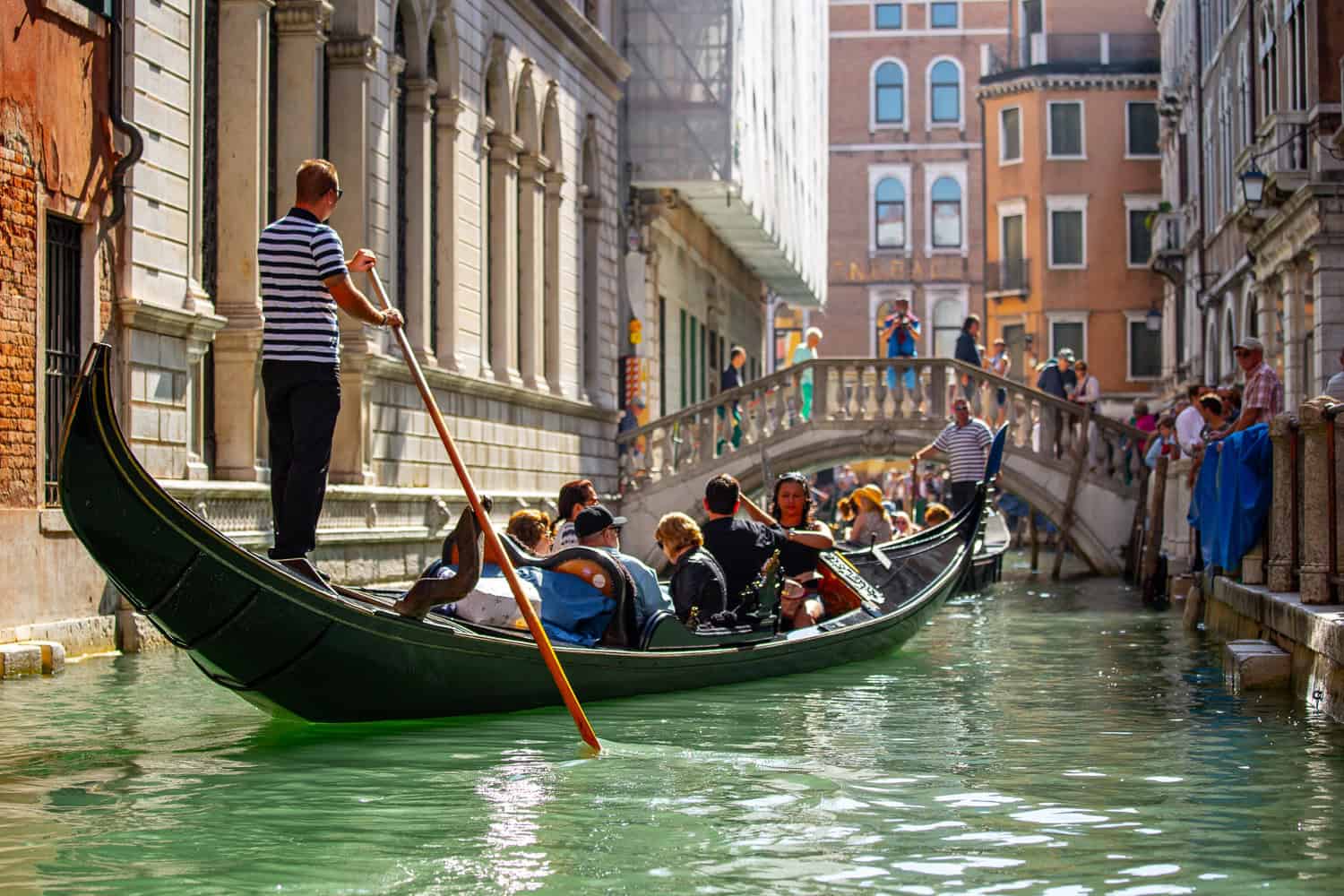
Doge’s Palace
A magnificent Gothic masterpiece that was once the heart of Venetian power. Situated on St. Mark’s, it served as the residence of the Doge. Today, it’s a museum showcasing the city’s rich history and artistic heritage. Visitors can explore its ornate chambers, including the opulent Golden Staircase and the Senate Hall, adorned with intricate frescoes and sculptures. The infamous Bridge of Sighs, connecting the palace to the prison, symbolizes Venetian justice and intrigue.
- Best Time to Visit: Early morning or late afternoon to avoid peak crowds.
- Hours: Generally open from 9:00 AM to 7:00 PM (hours may vary by season).
- Tips: Purchase skip-the-line tickets in advance to avoid long waits. Consider a guided tour for deeper insights into the palace’s history and artwork.
- Transportation: Easily reachable by Vaporetto to the San Zaccaria or San Marco stops.
- Tours: Choose from various private guided tours around the city to get the most bang for your buck.
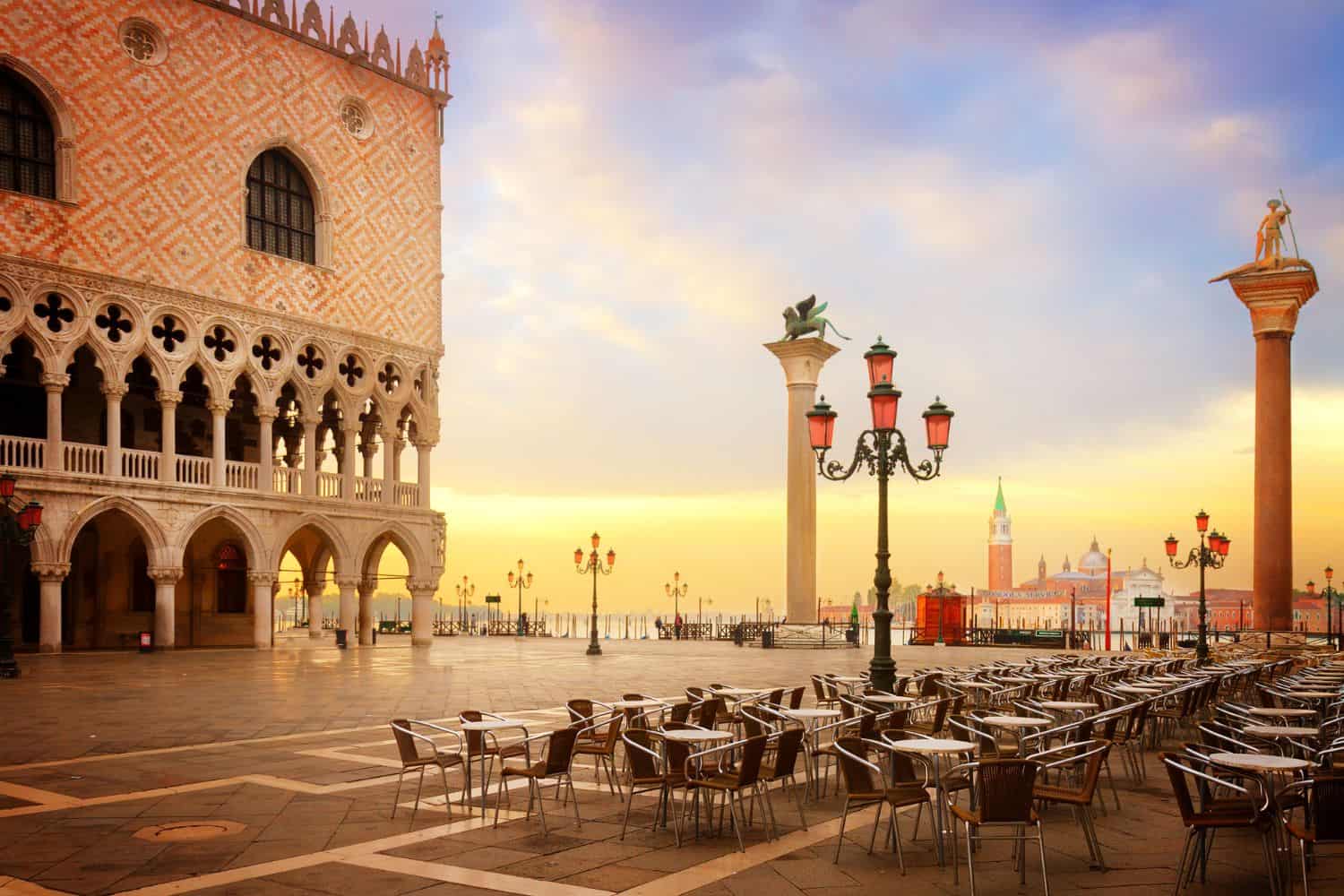
Accademia Bridge
A graceful wooden pedestrian bridge offers an unparalleled view of the Grand Canal. Its timeless design, blending seamlessly with the Venetian architecture, provides a picturesque vantage point for admiring the city’s iconic landmarks. As the sun dips below the horizon, casting a golden glow over the canal, the Accademia Bridge becomes a magical stage for a breathtaking sunset spectacle. The interplay of light and shadow on the water, the reflection of the historic buildings, and the vibrant hues of the sky create a truly unforgettable experience.
- Best Time to Visit: Early morning or late afternoon for quieter moments and beautiful lighting. Evening visits offer romantic views with the city lights reflecting on the Grand Canal.
- Hours: Open 24/7 as it is a public pedestrian bridge.
- Tips: The bridge offers one of the best panoramic views of the Grand Canal, including a perfect sightline to the iconic Basilica di Santa Maria della Salute. Ideal for photography, so have your camera ready!
- Transportation: Easily accessible by Vaporetto; use lines 1 or 2, and get off at the Accademia stop. Walking from nearby attractions like St. Mark’s or the Rialto Bridge is also a pleasant option.
- Tours: There are many available walking tours of Venice that often include the Accademia Bridge. These tours provide historical context and guided exploration of the surrounding Dorsoduro district, which is rich in art and architecture.

Other Unique Experiences in Venice
Wine & Food Tasting Tour
Venice isn’t just a visual feast; it’s also a culinary paradise! Dive into the delicious world of Venetian wines with an insider’s wine crawl that takes you to six different spots around the city. Savour the flavours of Veneto wines paired with mouthwatering local dishes made from fresh ingredients. As you sip and snack, you’ll hear fascinating stories about each neighbourhood and learn how to pick out the best wines like a true Venetian. Forget the tourist traps—this is your chance to eat, drink, and explore like a local.
Carnival of Venice
Imagine a city transformed into a fantastical realm of masks and mystery. That’s the Carnival of Venice, an annual spectacle that captivates the world with its opulence and intrigue. As the city’s canals and squares come alive with vibrant colours and elaborate costumes, it’s like stepping into a living, breathing fairytale. From the iconic Venetian masks (maybe even try making one of your own!), each with its own unique story, to the dazzling parades that wind through the city, every moment is a feast for the senses.
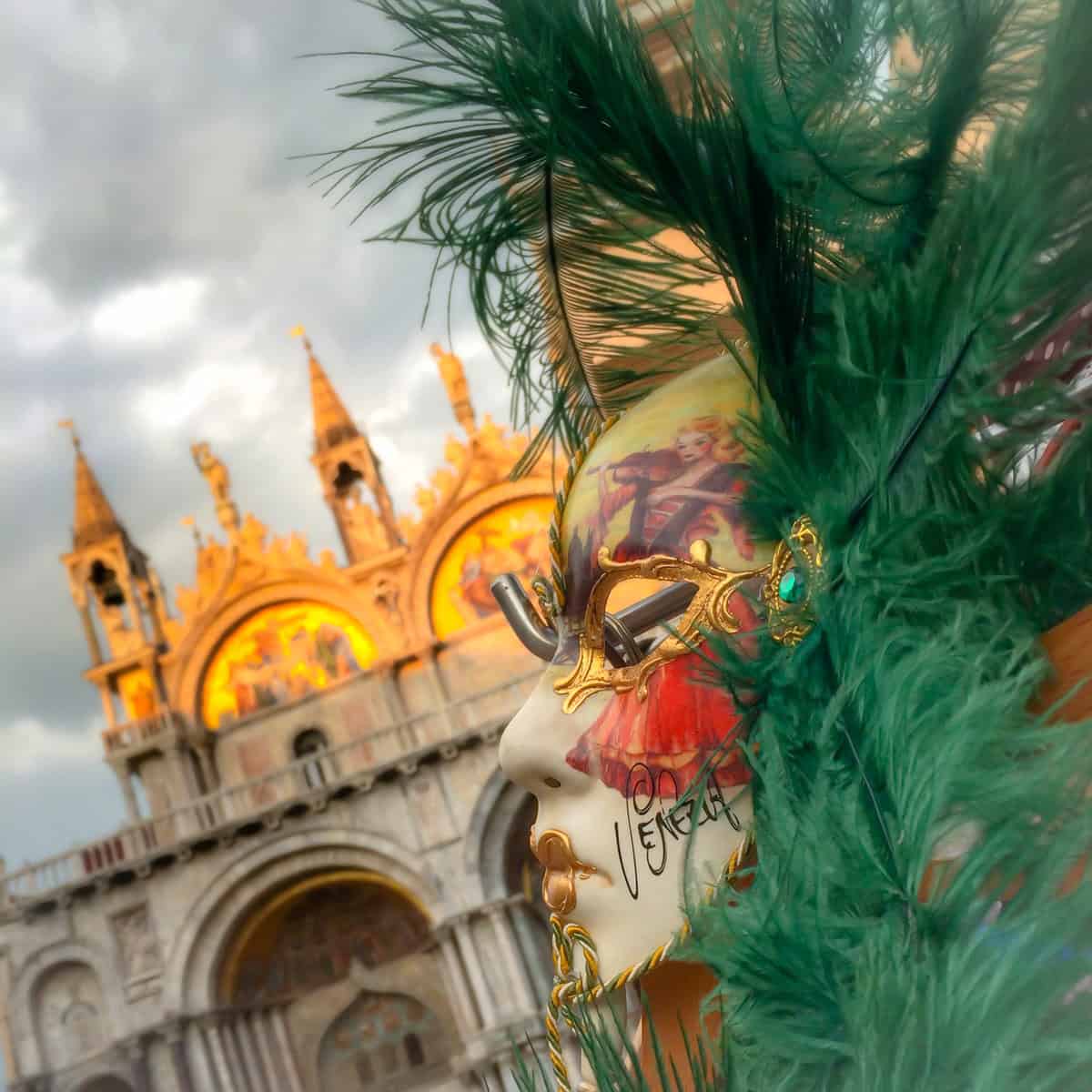
Day Trips to the Islands
Embark on a delightful adventure to the nearby islands of Murano, Burano, and Torcello, each brimming with its own unique flair. Murano dazzles with its world-famous glass artistry—watch the masters at work. Burano will charm you with its vibrant, rainbow-hued houses and intricate lacework, perfect for those Insta-worthy shots. Torcello, the quieter, mysterious sibling, invites you to wander its ancient streets and discover its historic cathedrals. It’s a trifecta of Venetian charm that’s sure to leave you enchanted.
Murano Glass Factory Tour
Step into a world of shimmering beauty at Murano’s famous glass factories, where centuries-old artistry comes alive. Watch master artisans transform molten glass into exquisite vases, intricate chandeliers, and vibrant sculptures with breathtaking precision. The rhythmic clanging of tools and the glow of the furnace add to the mesmerizing experience. A visit to a Murano glass factory is a must, offering a newfound appreciation for the craftsmanship behind these stunning creations.
Kayak the Canals
Ready to explore Venice from a whole new angle? Jump into a kayak and paddle through the city’s historic canals on this eco-adventure tour. Expert guides will lead you through the watery arteries of Venice, sharing fascinating stories about the city’s history and culture. No kayaking experience is needed–you’ll be provided with all the gear and instruction you need. So, grab your paddle, hop in, and get ready for a splashin’ good time.
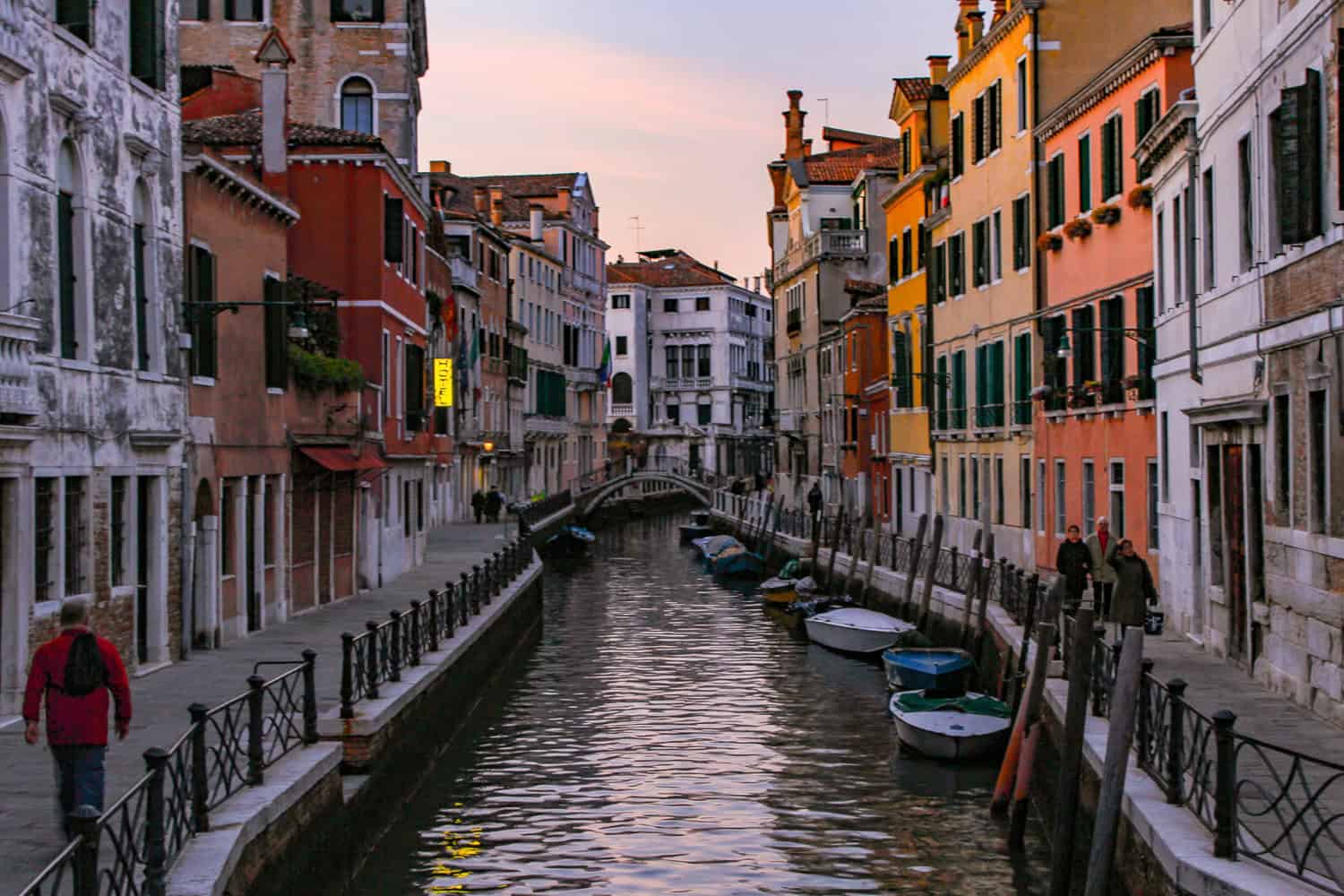
What and Where to Eat in Venice
Venetian cuisine is known for its seafood dishes and fresh pasta. Here are a few must-try specialties on the Venic food scene:
- Risotto al Nero di Seppia: This is a Venetian delicacy – a black risotto made with squid and ink, giving it a black colour.
- Baccalà alla Vicentina: A traditional Venetian dish made with salted cod, polenta, and onions.
- Cicchetti: Small, Venetian tapas-style snacks that are perfect for sharing.
- Prosecco: Enjoy a glass of sparkling Prosecco, a famous Italian wine produced in the Veneto region.

Restaurants in Venice
- Antico Ristorante Al Squero: Nestled along the Grand Canal, this charming restaurant offers breathtaking city views while serving up traditional Venetian cuisine. Their seafood dishes, especially the grilled octopus and the risotto with seafood, are highly recommended.
- Trattoria Alla Madonna: This family-run trattoria in the Cannaregio district is known for its authentic and affordable Venetian fare. Their homemade pasta dishes and hearty meat dishes are a must-try.
- All’Osteria di Santa Marina: Located near the Rialto Bridge, this restaurant specializes in Cicchetti, Venetian-style tapas. Their small plates are perfect for sharing and sampling a variety of flavours.
- Ristorante Agli Artisti: This historic restaurant near Campo Santa Margherita is a popular spot for locals and tourists alike. Their menu features classic Venetian dishes with a modern twist, and the atmosphere is warm and welcoming.
- Gelateria Grom: For a sweet treat, head to Gelateria Grom, a renowned chain known for its high-quality, artisanal gelato. Their flavours are made with fresh, natural ingredients and are sure to satisfy your sweet tooth.
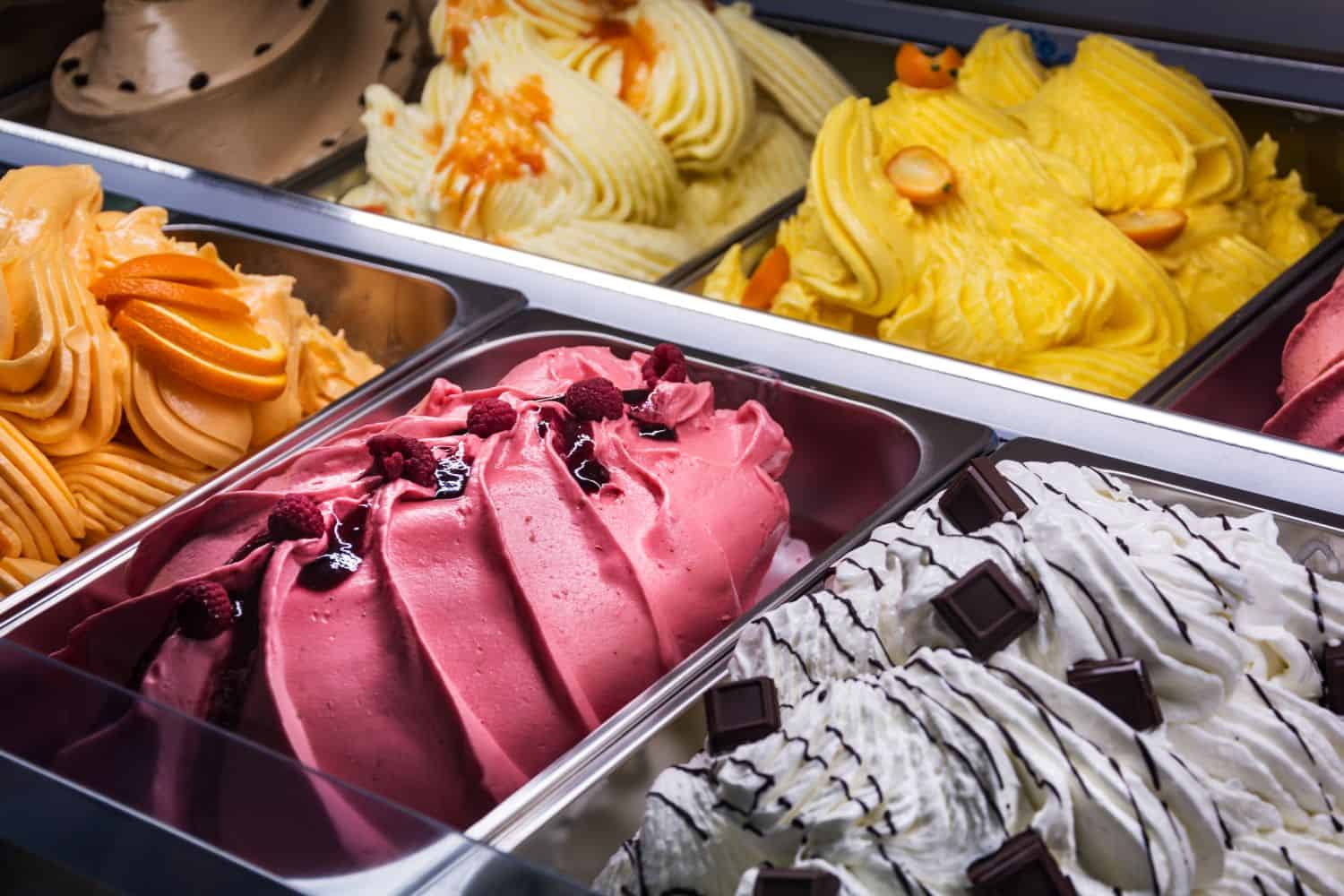
Where to Stay in Venice
Venice offers a variety of accommodation options, from luxury hotels to budget-friendly hostels. Consider staying in the historic center for easy access to the city’s attractions. Some popular neighbourhoods include San Marco, Dorsoduro, and Cannaregio.
Aman Venice
Located in a 16th-century palazzo on the Grand Canal, Aman Venice offers a luxurious and intimate experience with opulent interiors, beautiful gardens, and impeccable service. It combines historic elegance with modern comfort, featuring original frescoes and chandeliers.
The Gritti Palace
The iconic Gritti Palace hotel boasts a rich Venetian history and a prime location on the Grand Canal, with stunning views of the Basilica di Santa Maria della Salute. Its interiors are lavishly decorated with antique furniture, Murano glass, and Renaissance art, making it a favourite for those seeking a truly Venetian experience. The pricey nightly stays are definitely worth treating yourself.
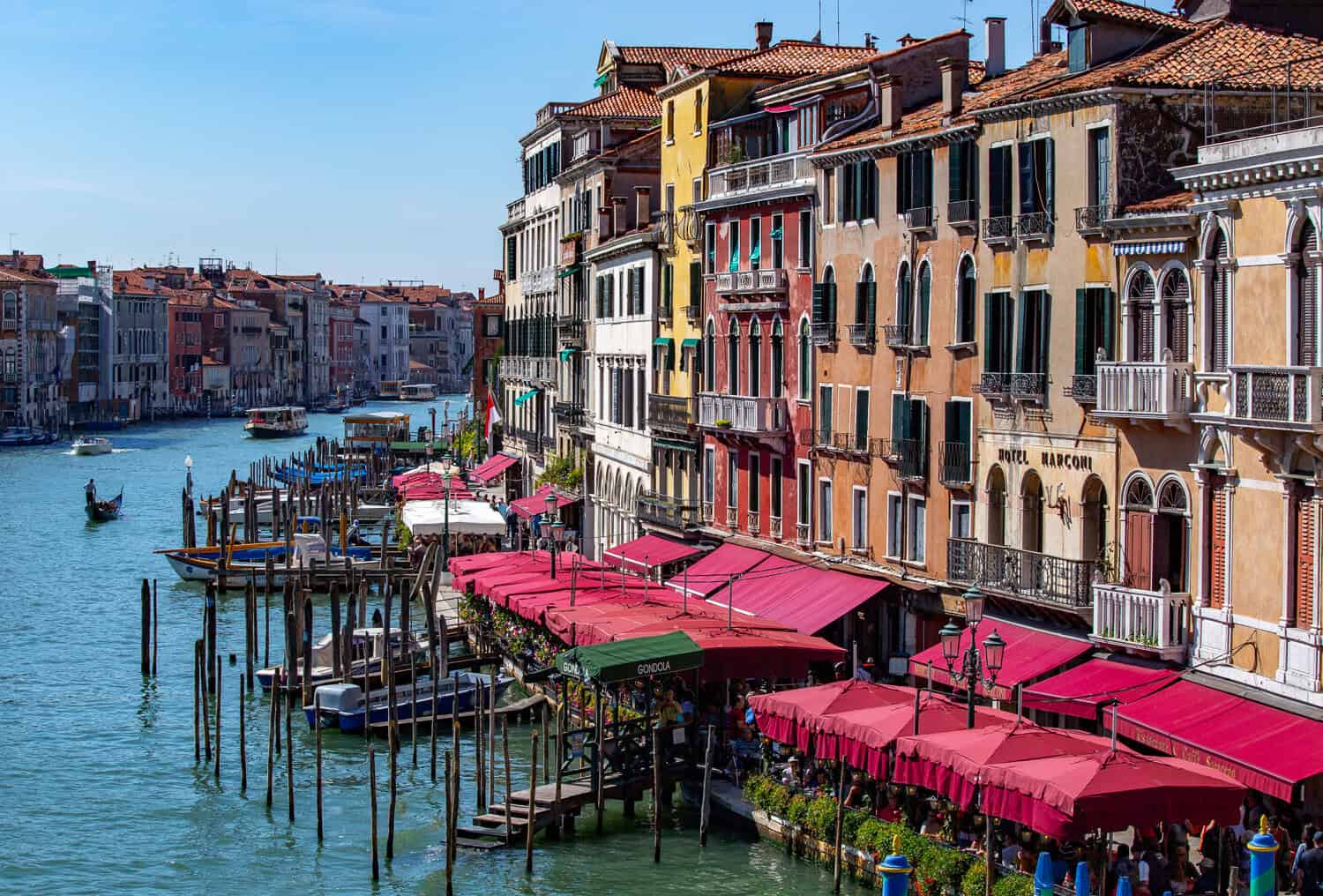
Hotel Danieli
Known for its regal atmosphere and located just steps from St. Mark’s, Hotel Danieli is a Venetian landmark. Its grand décor reflects the city’s historical grandeur, with marble staircases, antique furnishings, and luxurious rooms that blend classic opulence with modern amenities. The hotel faces the Venetian lagoon and is just a few steps away from San Marco, making it one of the most popular hotels in Venice.
Belmond Hotel Cipriani
Situated on Giudecca Island, Belmond Hotel Cipriani offers an exclusive and tranquil escape with breathtaking views of the Venetian lagoon and St. Mark’s Square. It features Venice’s only Olympic-sized swimming pool, lush gardens, and exceptional dining options, perfect for travellers seeking both privacy and luxury.
Ca’ Sagredo Hotel
A 14th-century palazzo has been transformed into the boutique hotel Ca’ Sagredo located along the Grand Canal. With its ornate ceilings, beautiful frescoes, and museum-worthy art collection, Ca’ Sagredo offers guests the unique experience of living in a piece of Venice’s artistic heritage. Each room has antique furniture and original works of art, making it a popular hotel among guests.
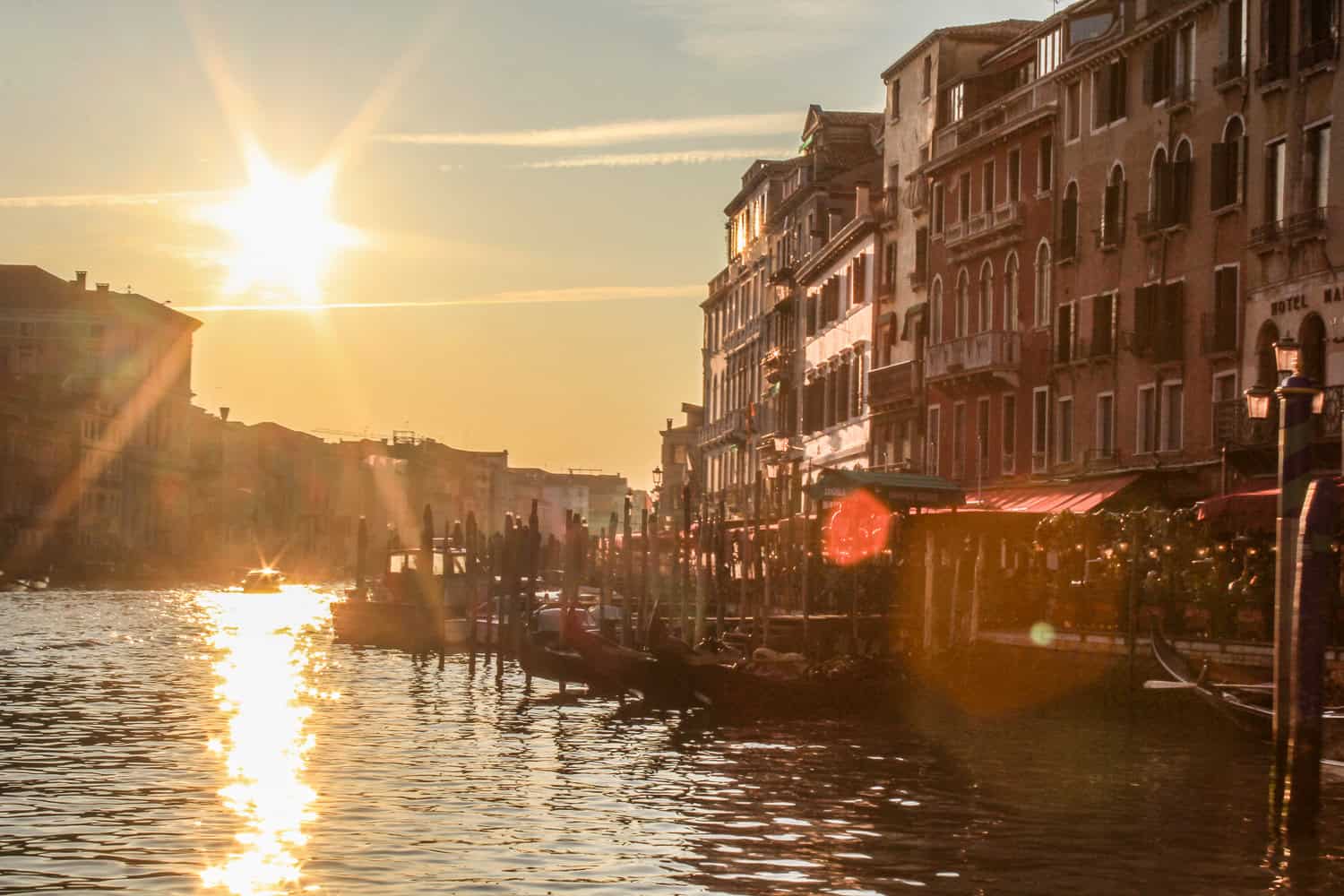
Our Recommendation:
We Choose Florence
For us, Florence wins. After visiting both Italian cities numerous times, our heart is in the Tuscan countryside. Now, don’t think that this decision came easy. We love visiting Venice. But for us, the more laid-back vibe, the stunning architecture, no tourist tax (yet) and wandering through Florence’s city centre are what won us over. Oh, and the porchetta. In Florence, we’ve probably eaten one of the best sandwiches of our lives, and that alone may prompt us to book a flight there.
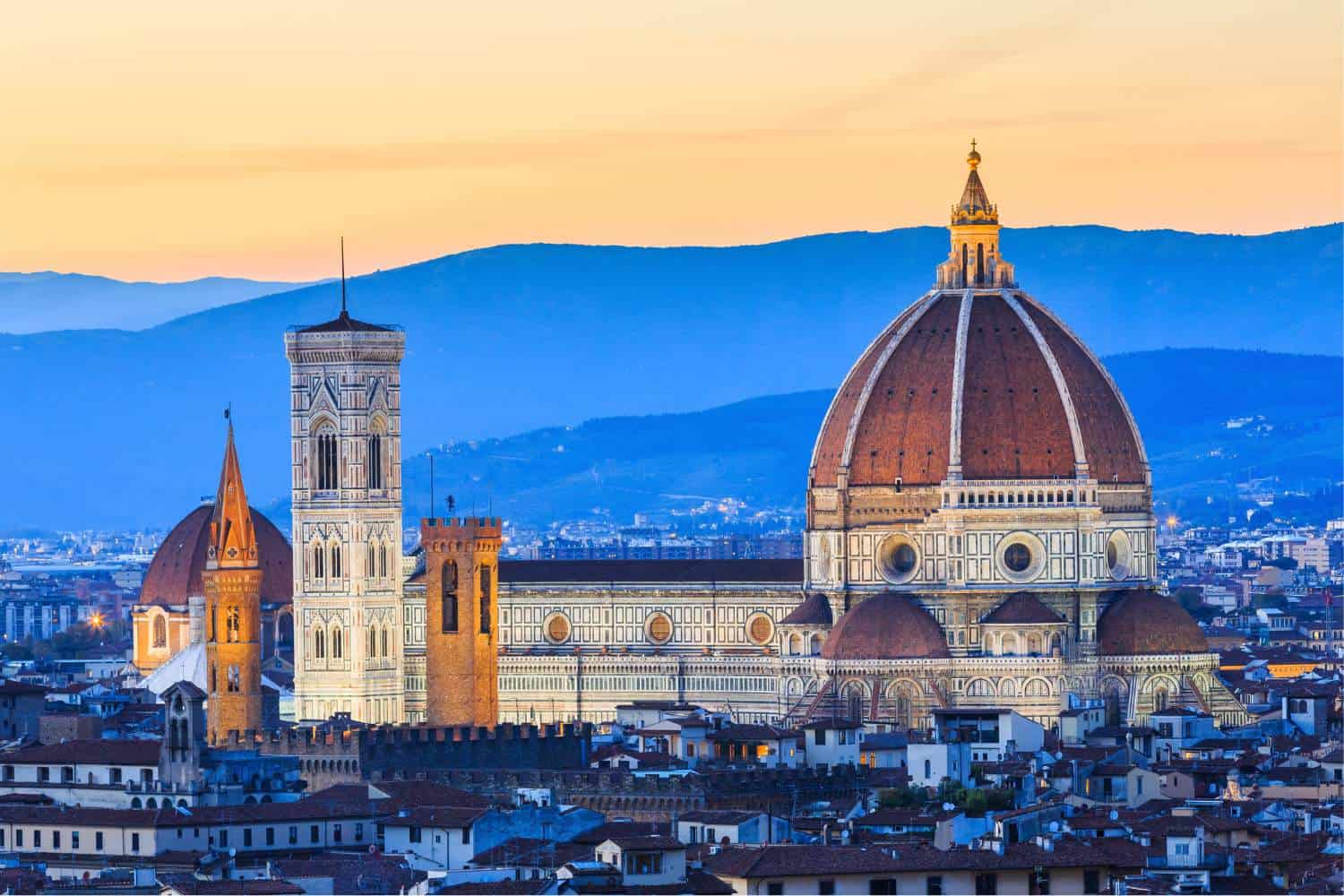
So, what do you think? Would you rather go to Florence or Venice?

